IS NEVER AGAIN BECOMING
TIME AND
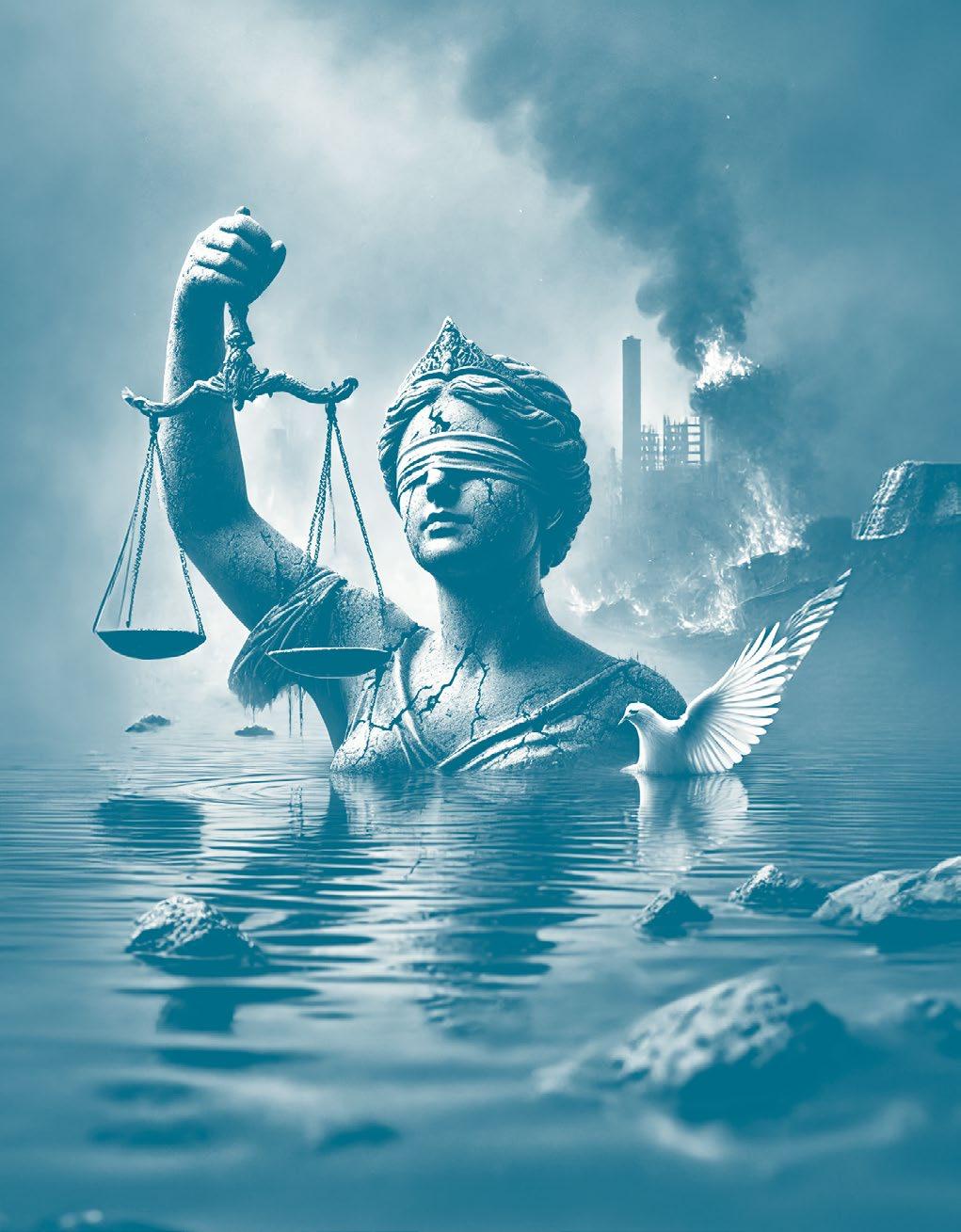
AGAIN?
THE CYCLE OF CONFLICT, INJUSTICE, AND ENVIRONMENTAL
COLLAPSE


IS NEVER AGAIN BECOMING

AGAIN?
THE CYCLE OF CONFLICT, INJUSTICE, AND ENVIRONMENTAL

UNICRI
Marina Mazzini
Leif Villadsen
Ghent University
Tom Vander Beken
Jelle Janssens
Noel Klima
Editor-in-Chief
Marina Mazzini
Graphic and cover layout
Antonio di Vico
Cover image generated using AI by OpenAI’s image tool
The views expressed are those of the authors and do not necessarily reflect the views and positions of the United Nations. Authors are not responsible for the use that might be made of the information contained in this publication.
Contents of the publication may be quoted or reproduced, provided that the source of information is acknowledged.
The designations employed and the presentation of the material in this publication do not imply the expression of any opinion whatsoever on the part of the Secretariat of the United Nations and UNICRI, concerning the legal status of any country, territory, city or area or of its authorities, or concerning the delimitation of its frontiers or boundaries.
The mention of specific institutions, companies or of certain manufacturers’ products does not imply that they are endorsed or recommended by the Secretariat of the United Nations or UNICRI in preference to others of a similar nature that are not mentioned.
The cycle of conflict, injustice, and environmental collapse





Hate speech and the seeds of genocide: a call to action by
Alice Wairimu Nderitu
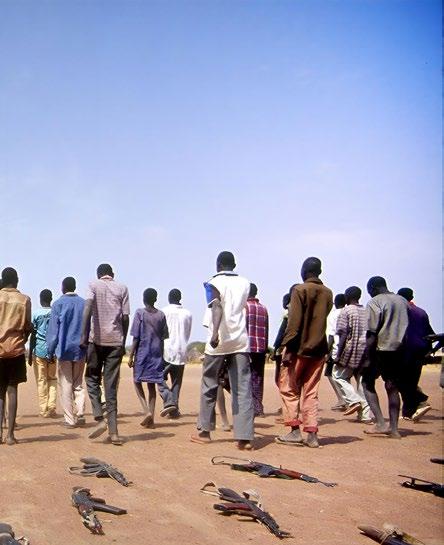
Role of youth in advocating against “weapons of widespread destruction”
by Monalisa Hazarika, United Nations Youth Champion for Disarmament
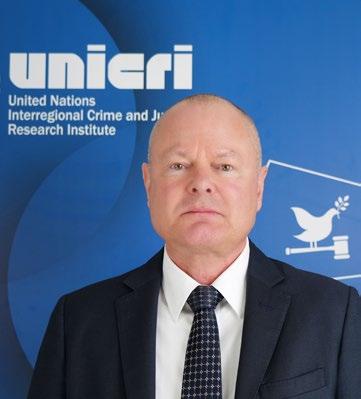
by Leif Villadsen Acting Director of UNICRI

Human trafficking and the hidden link to the climate change crisis by
Maria Paula Zamorano Castano
WE THE PEOPLES OF THE UNITED NATIONS DETERMINED to save succeeding generations from the scourge of war, which twice in our lifetime has brought untold sorrow to mankind, and to reaffirm faith in fundamental human rights, in the dignity and worth of the human person, in the equal rights of men and women and of nations large and small, and to establish conditions under which justice and respect for the obligations arising from treaties and other sources of international law can be maintained, and to promote social progress and better standards of life in larger freedom.”
With these words, the Charter of the United Nations, our founding document, entered into force in 1945, committing a world that had just witnessed the horrors of World War II to laying the foundations for a new era. Yet, the promise of peace has not been fully realised. If we could speak on behalf of the millions of victims of World War II and the countless wars and civil conflicts that have scarred humanity since 1945, they would tell us that the lessons of history have not been learned. >>>
The paradox of war is that it is desired by few, and there are never any true winners. The paradox of peace is that it is desired by all, as everyone would benefit, yet it remains elusive. This edition of Freedom from Fear addresses two types of conflict: those waged by humans against each other and those waged against nature. Neither has victors, only victims. Both reveal a failure of humanity to evolve.
The common thread linking these conflicts is crime and injustice. Crime and extremism thrive in conflict and often serve as the root causes of wars; injustice provides the foundation upon which wars and hatred are built. In a world of deep inequalities and systemic injustices, these forces find fertile ground to grow, further destabilising and polarising societies, making them more vulnerable to violent conflicts and environmental destruction.
Humanity can no longer afford wars, nor can it continue destroying the Earth that sustains it. The technological tools for destruction at our disposal today far exceed our capacity for survival. In recent years, one of the fastest-growing sectors has been arms production, to the detriment of the true priorities of humanity: peace, development, and the protection of our planet.
As Isaac Asimov’s First Law of Robotics dictates, “A robot may not harm a human being, or through inaction, allow a human being to come to harm.” This principle, though initially applied to robots, should guide the development of all technologies and serve as a moral compass for humanity. These rules remind us of the dangers of innovation disconnected from ethics. Instead of rushing toward the militarisation of emerging technologies, we must ensure that technological progress serves the greater good.
It is time to reaffirm our commitment to environmental protection, sustainable development, and peace through multilateralism. We must acknowledge that tackling these global challenges requires more than just national or regional self-interest; it demands a unified, international approach.
Divisions, intolerance, and the wrong assumption that a belief, group, or ideology should prevail over others, and the greed to further exploit our planet are contributing to fuel conflicts. The risks of national and regional conflicts, climate change, biodiversity loss, and resource depletion demand urgent, coordinated global action. Investing in green technology, sustainable development, and conflict prevention is not only a moral imperative but also the most effective
path to prosperity for all and long-term security.
At the same time, ensuring justice and combating crime, corruption, and extremism is critical to addressing the many global crises that are either fuelled or exploited by transnational organised crime and extremist groups. These forces thrive in environments of injustice, where people feel excluded, oppressed, or deprived of opportunity. Tackling the root causes of crime and extremism, as well as their infiltration at all levels of society, through the promotion of development and justice, can help prevent violent conflicts and environmental crimes, including the illegal exploitation of natural resources. A just world is not only a safer one but also a place where people are less vulnerable to those who seek to destabilise and polarise societies for their own ends.
When we speak of crime and extremism, we must also acknowledge the complicity of many corrupt institutions and private entities. Crime and extremism would not flourish without economic interests or misguided political choices. The simplistic division between “good” and “evil” is reductive. The grey zone where these actors converge is a noman’s land, one that we must confront with clarity and determination.
This grey zone is not merely a space of moral ambiguity but a critical battleground where corruption, economic greed, and failed governance intersect, creating the conditions for violence, extremism, and exploitation to flourish. To dismantle crime and extremism, we must confront not only the visible symptoms but also the underlying systems and interests that perpetuate them in many contexts. Working within this complex and uncomfortable space is essential if we are to build a world grounded in justice and peace. Cooperation with governments, the private sector, civil society, and the media is essential to eradicate the culture of illegality that has infiltrated many sectors
During the recent General Assembly, world leaders adopted the “Pact for the Future” on 22 September 2024, a landmark agreement that aims to transform global governance. The Pact includes the Global Digital Compact and the Declaration on Future Generations and is the most comprehensive reform in decades. Key elements of the Pact include reforms to the UN Security Council, renewed commitments to nuclear disarmament, and measures to prevent the weaponisation of emerging technologies. It also focuses on sustainable development, climate change, financial reform, and digital cooperation, while emphasis-
ing youth, future generations, human rights, and gender equality.
Multilateralism, based on cooperation and collective decision-making, remains the most effective way to address global challenges. No single nation can solve these problems alone, especially when the majority of the world’s population desires peace, justice, and dignity. International institutions, conventions, treaties, and agreements are vital platforms that amplify the voices of less powerful countries, and vulnerable populations ensuring that global policies reflect the will of the many, not the few. This collaborative approach is crucial to fostering a world where diplomatic solutions are prioritised over military interventions, and where global resources are directed toward improving lives rather than escalating conflicts.
Most people on this planet wish to live free from war, inequality, and environmental destruction. Global leaders must respond to this common aspiration by embracing multilateralism and prioritising policies that advance peace, justice, and sustainability. By working together, we can address the current crises and create a world where all people, regardless of nationality, ethnicity, or faith, can live with dignity. The Pact for the Future offers a clear framework, but
it will only succeed if we unite our efforts and prioritise the well-being of both people and the planet. This is our chance to build a just, peaceful, and sustainable world for future generations.
We must recognise that we stand at a pivotal moment in history: the actions we take today will shape our future and set a lasting course for younger generations to follow. We are handing them a world in crisis, burdened by polarization, conflict and environmental degradation. Yet, we have the opportunity to offer them something far more meaningful to believe in and work towards - a vision of a world where peace, justice, and cooperation form the foundation for a better, sustainable future. However, this vision must be backed by genuine global will and concrete action
by Alice Wairimu Nderitu, Under-Secretary-General and Special Adviser on the Prevention of Genocide
This year, 2024, marks the 30th anniversary of the 1994 genocide against the Tutsi in Rwanda, a moment in history that painfully reminds us of the devastation caused by unchecked hatred. In less than 100 days, over 800,000 people - mostly Tutsi, but also Hutu and others who opposed the violence - were systematically slaughtered. As we remember this tragedy, we are compelled to act and prevent genocide and related crimes from ever happening again. The genocide against the Tutsi in Rwanda, along with other dark episodes of history, demonstrates how hate speech can escalate from words into weapons of mass violence, turning neighbors into enemies.
Next year, 2025, will mark the 30th anniversary of another tragedy, the genocide in Srebrenica, where 8,372 Bosnian Muslims were brutally executed. In the words of the
United Nations Secretary-General António Guterres: “The genocide in Srebrenica stands as a harrowing testament to the devastating consequences of inaction in the face of hatred. We must fight against division and intolerance, stand up for human rights, and promote mutual understanding and reconciliation. May the memory of Srebrenica strengthen our resolve to build a world free from the scourge of genocide – a world where justice and peace prevail, where ‘never again’ is a solemn promise fulfilled for all humanity.”
My participation in KWIBUKA30 earlier this year, Rwanda’s 30th annual remembrance of the 1994 genocide against the Tutsi, reaffirmed the importance of these lessons. The 100 days of commemoration serve as a reminder that genocide begins long before the violence erupts, often with the slow but steady spread of hate speech

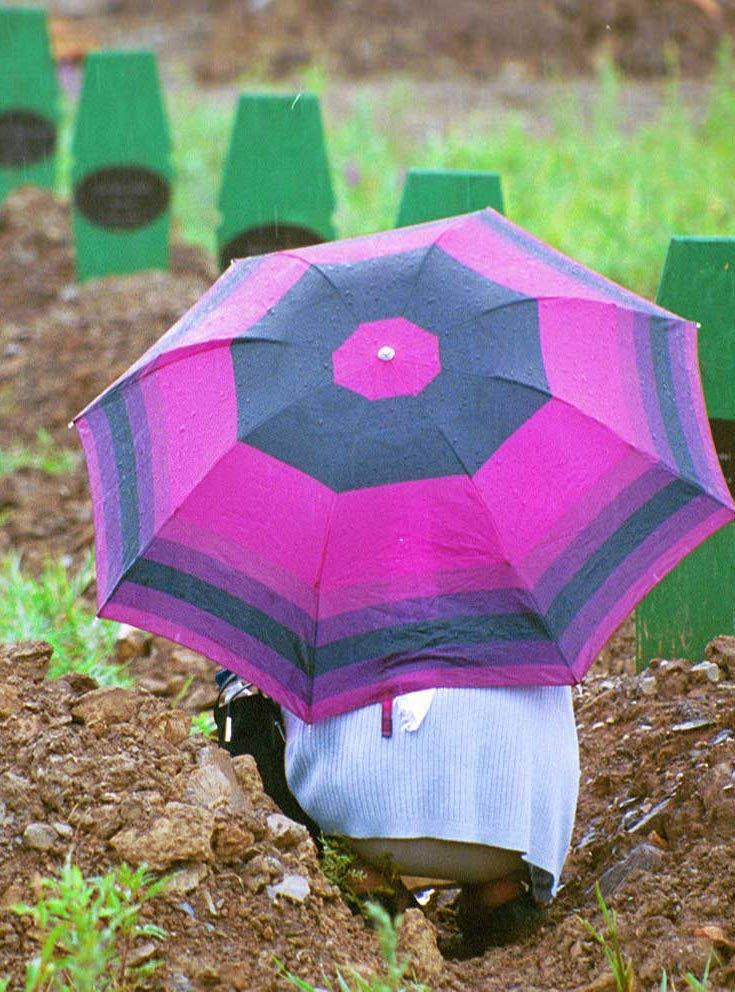
Those with influence can now incite hatred, division, and dehumanization with unprecedented ease, turning digital platforms into tools of violence

and propaganda that dehumanizes entire communities.
Hate speech deepens societal divides, exacerbates inequalities, and weakens social cohesion. It is not simply harmful rhetoric; it is a precursor to targeting people based on their identity, mass violence, and even genocide. The international courts have conclusively shown that hate-filled propaganda played a central role in the 1994 genocide against the Tutsi in Rwanda. Today, we face an even greater challenge as hate speech, amplified by social media, spreads faster and reaches wider audiences than ever before. Those with influence can now incite hatred, division,
and dehumanization with unprecedented ease, turning digital platforms into tools of violence.
History proves that no genocide has occurred without the destructive force of hate speech directed at the targeted group. Whether in the Holocaust, Rwanda, Bosnia, Myanmar, or Iraq, political leaders, media figures, and others in power have used hate speech to strip targeted communities of their humanity, creating the conditions for genocide and related crimes. This is happening again, as social media accelerates the spread of these toxic narratives, making vulnerable groups more susceptible to violence and exclusion.
The enemy is no longer seen as human but as an existential threat, justifying acts of extreme violence
Dehumanization remains one of the most powerful tools in modern conflicts. The enemy is no longer seen as human but as an existential threat, justifying acts of extreme violence. The deliberate dehumanization of national, ethnic, racial or religious groups has been a common tactic in genocides throughout history, allowing ordinary people to accept or even participate in genocide and related crimes against civilians, including women and children.
In today’s world, this strategy has evolved into more sophisticated technological methods. Digital platforms are being weaponized to spread hate at scale, making dehumanization a calculated and far-reaching process. It is not just about fostering fear of the “other,” but about creating an environment where the annihilation of entire groups becomes acceptable.
Despite the lessons of history, we continue to witness the rise of hate speech, fueling new conflicts, genocide, and related crimes. The international response, however, is often slow, fragmented, and lacking in political will. Communities remain at risk as the world hesitates to act on the early warning signs, including the spread of hate speech.
The situation in Sudan serves as a painful reminder of the dangers posed by hate speech and impunity. For over a year, the country has been engulfed in violence, with tens of thousands killed and millions displaced. Civilians, including children, face widespread violence, while women and girls are subjected to rampant sexual violence.
Despite repeated alarms about the risk of genocide, war crimes and crimes against humanity, violations continue unabated. Ethnic and racial identities are being exploited, particularly in Darfur, where the Rapid Support Forces (RSF) and allied militias have attacked the Masalit and other non-Arab communities. Hate speech, often spread via social media, has further fueled divisions and violence.
A recent UN Fact-Finding Mission confirmed that both the Sudanese Armed Forces (SAF) and RSF are responsible for grave human rights abuses, including indiscriminate airstrikes, attacks on civilians, and destruction of critical infrastructure. The impunity with which these crimes are committed has entrenched the violence, setting the stage for future genocide and related crimes.

I call upon all those in positions of influence to strengthen diplomatic and humanitarian efforts to address the crisis in Sudan. We must also support local initiatives aimed at reconciliation and protection, while ensuring that justice is served. Accountability is key to breaking the cycle of violence. As Secretary-General Guterres rightly said, “Impunity in the past is directly contributing to violence in the present and, if not halted, will plant the seeds for violence in the future.”
Impunity for perpetrators of genocide and related crimes remains one of the most dangerous risk factors for future violence. When justice is denied, it sends a message that such crimes can be committed without consequences. This undermines not only peace efforts but also the broader goals of reconciliation. As we reflect on the 30 years since the 1994 genocide against the Tutsi in Rwanda, the fact that more than 1,000 indictments and arrest warrants remain unexecuted is unacceptable. Holding perpetrators accountable is not just a legal duty but a moral one.
Prevention, however, goes beyond accountability. It requires addressing the root

causes and early warning signs of genocide. The UN’s Framework of Analysis for Atrocity Crimes provides a vital tool for identifying these risk factors. Strengthening national and regional mechanisms to detect and respond to these risks is crucial. This includes supporting National Committees for the Prevention of Genocide, which play an essential role in developing laws to promote tolerance and combat discrimination.
The United Nations has made combating hate speech a global priority through its Strategy and Plan of Action on Hate Speech

The United Nations has made combating hate speech a global priority through its Strategy and Plan of Action on Hate Speech, which emphasizes a whole-of-society approach. Governments, civil society, tech companies, and individuals must all work together to address this challenge. Social media, while offering unprecedented opportunities for connection, has also become a breeding ground for hate. The speed at which harmful narratives can spread online demands that we adapt our strategies, engage tech companies, and develop rapid-response mechanisms.

Local ownership of counter-hate speech initiatives is crucial. The most effective mechanisms are those developed in partnership with the communities they aim to protect. Education, sports, religious leaders, and community figures all play critical roles in promoting tolerance and social cohesion.
Education is another cornerstone of prevention. Teaching our children that diversity is a strength, not a threat, is vital to fostering a more inclusive and peaceful society. Schools, families, and communities all have a role in instilling these values. We must also ensure that laws against hate speech that constitute incitement to discrimination, hostility or violence are enforced, as small crimes left unchecked can escalate into genocide and related crimes.
Women, too, are critical in the fight against hate speech and violence. They often bear the brunt of gender-based hate, but they also play key roles in peacebuilding and conflict resolution. The Napoli Plan of Action for Women in Communities to Counter Hate Speech and Prevent Incitement to Violence that Could Lead to Genocide and Related Crimes (War
Crimes and Crimes Against Humanity), launched in 2022, highlights the importance of including women in efforts to prevent violence and promote peace.
We urgently need the media to step up and take responsibility in the fight against hate speech. As powerful platforms of communication, both traditional and social media play a pivotal role in shaping public opinion and social dynamics. It is essential that they not only refrain from amplifying harmful narratives but also actively promote accountability, truth, and respect for diversity. To truly combat the proliferation of hate speech, we must foster local and global networks of media outlets, journalists, and community leaders who are
committed to countering hate with responsible reporting and positive engagement. By creating these networks, we can build a united front that empowers communities to resist division, spread messages of peace, and promote social cohesion. The media’s role in this endeavor is not optional; it is essential to the prevention of violence and the protection of vulnerable groups.
As we look to the future, let us be guided by the lessons of the past and the voices of those who have suffered the consequences of our inaction. The prevention of genocide and related crimes is a collective responsibility that falls on each of us - governments, communities, and individuals alike. Together, we can build a world where hate speech is not a precursor to violence, but a call for dialogue, understanding, and peace.
When justice is denied, it sends a message that such crimes can be committed without consequences
The stakes are too high, and the cost of inaction is too great. By addressing hate speech, promoting justice, and fostering respect for diversity, we honor the memory of those we have lost and protect the dignity of all who live today.


Together, we can build a world where hate speech is not a precursor to violence, but a call for dialogue, understanding, and peace
Alice Wairimu Nderitu is Under-Secretary-General and Special Adviser on the Prevention of Genocide. She is a highly regarded figure in peacebuilding and the prevention of atrocity crimes, known for her role as a mediator in armed conflicts and her advocacy for women’s participation in peace processes. She has played a pivotal role in the African Union’s Fem-Wise Network and is a member of the Women Waging Peace Network and the Global Alliance of Women Mediators.
Ms. Nderitu has led several notable peace processes, including in Kenya, where she mediated the Nakuru County Peace Accord involving 10 ethnic communities, and in Nigeria, where she facilitated the Kafanchan Peace Declaration (Kaduna State) and the Southern Plateau Inter-Communal Peace Declaration (Plateau State), which involved a total of 85 ethnic communities.
She co-founded Community Voices for Peace and Pluralism, a network aimed at preventing and transforming violent ethnic, racial, and religious conflicts. As a former Commissioner of Kenya’s National Cohesion and Integration Commission (NCIC), she co-founded the Uwiano Platform for Peace, pioneering the use of mobile technology to monitor violence and hate speech, connecting early warnings to early response systems.
Ms. Nderitu has contributed to peace initiatives worldwide, setting up mechanisms for early warning and early response, while holding leadership roles in organisations such as Fahamu and the Kenya National Commission on Human Rights. She has been involved in high-level peace mediation efforts through Concerned Citizens for Peace.
Her accolades include an Aspen Leadership scholarship, and she is a Transitional Justice Fellow and a Global Raphael Lemkin course alumna. She has also lectured at SIT Graduate School, USA, and Pretoria University, South Africa, and facilitated training for senior military leaders in Kenya and Rwanda. Widely published, Ms. Nderitu has received multiple global awards recognising her innovative approach to conflict resolution and mediation.

Judges overseeing war crimes investigations have scrupulous standards regarding photographic evidence
by Chris Stephen
One day in June 2011 Mark Ellis, the Director of the International Bar Association (IBA), took a phone call from a British television network. The network, Channel 4, wanted his opinion on horrific footage of atrocities filmed in Sri Lanka. The footage was part of a United Nations (UN) report into the civil war on the island. The TV station wanted to know how strong it would be as evidence in a war crimes trial.
Strong, Ellis told them. But he realised also there would be a problem. Most of the footage, which showed shellings, murder and mutilations, was provided anonymously. There was no way to check when it was shot, where it occurred, and, crucially, which army was responsible for the horrors depicted.
Without that, he realised, the evidence would likely be useless in a war crimes trial. Among other things, prosecutors would not be able to prove that the footage had not been tampered with.
“The videos Channel 4 asked me to view were so powerful and
emotive that I knew justice would eventually be served,” he said. “Shockingly, the next day, the government of Sri Lanka argued that the videos were fake, and, sadly, that argument could stand because the videos were sent anonymously. At that moment, I knew we needed a way to ensure the authenticity of this type of pictorial evidence.”
Judges overseeing war crimes investigations have scrupulous standards regarding photographic evidence. They need proof that it has not been tampered with, a near-impossible task for prosecutors. Ellis realised that existing technology couldn’t prove a photograph’s authenticity. He understood that what was needed was new technology. It was a daunting task because Ellis was not a technology expert. He needed to find experts, convince them to help, and secure funding to develop a technology accessible to ordinary citizens.
One thing that helped him was knowing that the history of war crimes justice is littered with examples of individuals who were willing to go the
extra mile. Researching my book, The Future of War Crimes Justice, I found that advances, both great and small, in war law, were the result not of committees or commissions, but of spirited individuals.
Typical was the first Geneva Convention. It was the work of one man, Henry Dunant, an eccentric Swiss businessman. He was shocked by witnessing the carnage of Italy’s battle of Solferino in 1859 and returned to Switzerland to found the Red Cross. Not content with that, he drew up a set of rules to protect the wounded in war. He then criss-crossed Europe, lobbying for a convention that was finally signed in 1864.
In London, Ellis channelled his ‘inner Dunant’ to lobby lawyers, technologists, and anyone else who would listen.
Four years later, the work paid off, with the launch of eyeWitness to Atrocities1
1 EyeWitness to Atrocities (eyeWitness) was launched in 2015 as an initiative of the International Bar Association (IBA). With the eyeWitness to Atrocities camera app (Android only), documenters can capture verifiable footage of international atrocity crimes, including war crimes, crimes against humanity, genocide, and torture.
Unlike footage captured with regular camera apps, eyeWitness footage is easily verifiable for courts of law and can be used as evidence for both accountability and advocacy. In consultation with app users, eyeWitness’ expert legal team also helps to ensure that this footage is actively used for justice. For example, in 2018, eyeWitness photos and videos were used to help convict two warlords of crimes against humanity in the Democratic Republic of the Congo. This was a historical moment as it was the first time a court of law had accepted mobile phone footage as evidence of core international crimes. Furthermore, whilst the app can be utilised independently, eyeWitness partners with many of the civil society groups, journalists, and civilians using the app to provide additional documentation training, legal expertise, and support.
EyeWitness supports hundreds of human rights defenders in countries around the world, including Nigeria, The Gambia, Senegal, Palestine, the Democratic Republic of the Congo, and Ukraine.

The eyeWitness footage can be sent anonymously, but comes with date and time stamps embedded in the file

It is a simple app, available for anyone with an Android phone to download for free. The app allows anyone witnessing war crimes to take photos or videos, then upload them to servers at Lexus Nexus. As a result, these images can be given to war crimes investigators.
“It was made possible because of the unified support and hard work of those involved with implementing the concept,” said Ellis. “And the fact that the IBA invested money to make it a reality.”
The eyeWitness footage can be sent anonymously, but comes with date and time stamps embedded in the file, along with the location of the nearest cellphone tower or Wi-Fi node. All this helps authenticate it when used as evidence in a trial. To protect users, the app also includes James Bond-style features, such as the ability to
instantly delete the entire app within seconds if a citizen-investigator is captured. Users can also disguise the app, giving the eyeWitness icon a different name. If a captor presses the disguised icon, they are directed to the regular photo file in the phone, instead of accessing the secret footage of war crimes. The IBA stresses that when recording war crimes, safety comes first. “Individuals documenting atrocities often operate in very dangerous circumstances. We stress to partners that no one should take unnecessary risks,” said eyeWitness Director Carrie Bowker.
The app was launched in 2015, and use skyrocketed with the start of the Ukraine war. Since the app’s launch, 65,000 files have been uploaded from users, with 20,000 of those coming in the past twelve months. Of those, two thirds have come from Ukraine.
“We have received an incredibly high volume of footage since Russia’s invasion (of Ukraine) in February 2022,” said Bowker.
To avoid being swamped, the IBA has a battery of volunteer lawyers who survey each image. Data administrator Christina Stevenson monitors images as they arrive, grading them according to their importance, and sending them on to the volunteer lawyers. She admits that the constant parade of horror can be disturbing. “It’s important to understand what vicarious trauma is and to take steps to safeguard against it. I find that a useful measure is to listen to music while viewing graphic images, in order to create some distance between myself and the footage.
Once stored, the images are available to the International Criminal Court (ICC) and a string of tribunals and investigators around the world.

Its images have already provided images for a trial at a military court in the Democratic Republic of Congo (DRC) and are likely to constitute an increasingly significant portion of war crimes evidence in coming years. In a world where everyone has a cellphone, the possibilities of the eyeWitness app are immense.
It is part of a wider revolution that has seen technology make war crimes harder to hide, and easier to investigate
Satellite photographs, once a rarity, are now ubiquitous in war crimes investigations. News organisations, notably the New York Times, have published a series of investigations into horrors in Ukraine, and Israel and Gaza using satellite technology. And image data
can provide evidence not just of the crimes themselves, but often of those behind them.
Proving who committed atrocities can be the hardest part of a war crimes trial. It can be difficult to reconstruct which unit was where in the chaos of battle. Yet digital images can serve as the vital link, often in unremarkable ways. Proof that a particular unit was in the area where crimes were committed might come from photos of the regimental flashes on their uniforms, or from facial recognition technology used to identify the soldiers. In Ukraine, the activities of the Russian units are often traced by the signal location and text messages of the soldiers themselves. In war crimes investigations, the key is to present a tapestry of evidence, with one layer overlaid over the next.
To prove the 1995 Srebrenica genocide in Bosnia, investigators at the International Criminal Tribunal for Former Yugoslavia seized tens of thousands of official dockets and files from surrounding Serb-held towns. These dockets showed the movement of dozens of buses, trucks and earth movers used by paramilitary forces for the killings and grisly burials. Investigators assembled a matrix of fuel requisition and movement notifications in a single electronic file, enabling judges to see the entire massacre as it unfolded.
The growth of the wired-world has also enabled war crimes prosecutors to go further than they have gone before, investigating not just generals and warlords, but the banks and corporations that sometimes support them.
In 2003, the first ICC Chief Prosecutor, Luis Moreno Ocampo, announced that mining companies aiding militias in the Democratic Republic of Congo could be investigated. In a speech to the ICC’s governing Assembly of States Parties, he declared: “Those who direct
mining operations, sell diamonds or gold extracted in these conditions, launder the dirty money or provide weapons could also be authors of the crimes. Even if they are based in other countries.”
The ICC has never prosecuted such cases. Among reasons cited are the sheer complexities involved. War crimes trials are already complicated affairs. They are, in effect, two-trialsin-one: first, the individual crimes themselves, and second, the task of showing they are part of a pattern, and proving a chain-of-command up to the suspect. Going after corporations that might sup -

port that suspect means a third step, involving examination of business and financial records.
But while the ICC has avoided corporate cases, several national courts in Europe have not. Last September, Sweden began the trial of two former executives of Lundin Oil, accused of aiding and abetting war crimes in Sudan. Switzerland is investigating a minerals trader for possible complicity in the Democratic Republic of the Congo (DRC) war crimes. Meanwhile, France is leading the way, with 14 corporate war crimes investigations underway. The most prominent is the trial of eight former executives of a construction giant, Lafarge, accused of complicity with the Islamic State in Syria.
The key factor in all these cases is the ability to find and make sense of huge quantities of data. These include not only files seized from companies, but also official data from the broader financial sector. The United States’ Securities and Exchange Commission, for instance, now requires companies working in the DRC to send it annual reports detailing which mines they use. Human rights groups can cross-check these records with mines known to be operated by warlords.

Although the technological revolution has simplified the tracing of corporations and any support they might provide to war criminals, the task remains complicated

The Lundin case is already scheduled to be Sweden’s longest-ever criminal trial, with closing arguments not due until March 2026. And the former executives insist they are innocent, arguing they were unaware of any crimes linked to their oil exploration activities.
Adding to the complexity of prosecuting corporate war crimes cases is the significantly higher burden of proof required, as opposed to other types of criminal cases. A mili-
tary commander can be jailed for crimes committed by their troops without direct evidence of the commander’s knowledge of those crimes.
In legal terms, a military commander is obligated to be aware of their forces’ actions. Should the crimes committed be widespread and systematic, the commander can be convicted even if there is no proof that they personally ordered such crimes. This principle underscores the concept of
command responsibility, where ignorance of subordinates’ actions does not absolve a commander of guilt. But for corporate figures charged with aiding and abetting war crimes, the legal requirements diverge. For these cases, it is imperative to provide concrete evidence that the executive knew that people they were funding or trading with were implicated in war crimes.
Proving such knowledge can be the hardest challenge in trials concerning complicity in war crimes. No corporate figure has ever been jailed for war crimes in recent history, but the charge was used in one of the most prominent war crimes trials of all: that of Charles Taylor, the former president of Liberia. Taylor was sentenced to 50 years in prison by the Sierra Leone Special Court for supporting murderous militias. These groups compensated him with so-called blood diamonds, which he then sold on the world market.
Prosecutors were able to prove the atrocities committed in Sierra Leone. They could also trace the diamond transactions back to Liberia. Nonetheless, Taylor insisted he did not know the groups he funded were committing crimes, pointing out he wa not even in Sierra Leone at the time.
His conviction was assured when prosecutors obtained testimony from insider witnesses who attested to Taylor’s awareness of the crimes. In future war crimes trials involving corporate figures, similar insider information may prove pivotal, potentially sourced from emails and electronic records.
For the moment, corporate war crimes cases are in their infancy, and much may depend on how efficient the first trials prove to be. “Corporations see it as something annoying, but
not something they are very afraid of,” said Julie Fabreguettes, an international law specialist attorney with VingtRue Avocats in Paris.
A key problem with international courts is their remoteness from the communities they are set up to serve. Devices such as the eyeWitness to Atrocities App put citizens back in the driving seat.
“The App is empowering for citizens,” said Oriol Galobart, Administrator of the eyeWitness to Atrocities programme. It provides individuals with a tool to make a difference and seek accountability and justice.”

Chris Stephen is the author of “The Future of War Crimes Justice”, published by Melville House UK. He has reported from nine wars for publications including The Guardian and The New York Times magazine. Additionally, he writes on war crimes developments for journals like the International Institute for Strategic Studies. Chris lives in London where he continues to provide analysis and reporting on issues related to war crimes and international justice.

by Benjamin Petrini
Non-state armed groups (NSAGs), including both nonstate actors and terrorist groups designated as such by the United Nations (UN) Security Council, have proliferated globally over the past decade. The number of conflicts involving NSAGs (when the state is not a conflict party) boomed during the same period, according to the Uppsala Conflict Data Program (UCDP). This trend has been particularly pronounced in Africa, the Middle East, and Latin America, underpinning fragmentation of armed conflicts and significantly contributing to the protractedness of situations of conflict and violence in these regions.
Currently, the world is witnessing the highest number of armed conflicts since the Second World War (Figure 1). According to the UCDP, in 2023, there were fifty-nine statebased armed conflicts globally, the highest number since 1946. Civil wars dominate the conflict landscape: in 2023, there were two inter-state conflicts (which although low in numbers, are highly destruc-

tive), thirty-seven internal conflicts, and twenty internationalised internal conflicts (i.e., with intervention by an external state).1 The latter has particu -
larly expanded in the last decade, according to the IISS: whereas external state intervention in civil wars used to be the exception after the Cold
War, it is now the norm. 2 Foreign militaries deployed in essentially domestic conflicts not only represent a return of geopolitical competition, but also a key constraint to conflict resolution efforts.
At the same time, the escalating trend of non-state conflicts has been even more remarkable. In the decade between 2013 and 2022, the average number of non-state conflicts was nearly seventy-six per year, while in the preceding two decades the average number was thirty-four (1993-2002) and thirty-five (2003-2012), respectively.3 Violent extremism has been on the rise globally, but
1 Davies, Shawn, Therese Pettersson and Magnus Öberg (2023). Organized violence 1989-2022 and the return of conflicts between states? Journal of Peace Research 60(4). Gleditsch, Nils Petter, Peter Wallensteen, Mikael Eriksson, Margareta Sollenberg, and Håvard Strand (2002) Armed Conflict 1946-2001: A New Dataset. Journal of Peace Research 39(5)
2 International Institute for Strategic Studies (2021). The Armed Conflict Survey 2021. Routledge, London
3 Davies, et al. (2023). Sundberg, Ralph, Kristine Eck and Joakim Kreutz (2012) Introducing the UCDP Non-State Conflict Dataset. Journal of Peace Research 49(2).
Source: Author’s elaboration from UCDP.
particularly in Sub-Saharan Africa: violent events perpetrated by Islamist groups on the continent quadrupled in the last ten years. Seemingly, NSAGs are one of the principal culprits of today’s prolonged and intractable nature of conflicts.
Non-state armed Groups (NSAGs) encompass a wide range of armed actors. These include insurgencies of various kinds (such as separatists, lib -
eration movements, or de facto authorities like Hamas in the Gaza strip before October 7), violent extremist and terrorist groups, militias and paramilitaries, as well as groups more criminal in nature, including organized crime, armed gangs, and traffickers, among others. They can operate across different (and often overlapping) spheres, including the local, national, transnational, and international levels. For example, violent extremist groups affiliated with ISIS and al-Qaeda in the Sahel region have become more localised in recent years. While their trans-
4 International Institute for Strategic Studies (2023). The Armed Conflict Survey 2023. Routledge, London.
national links have substantially weakened, these armed actors increasingly exploit local grievances, embed into local communities and operate in peripheral theaters, making counter-terrorist efforts ineffective.4
extremism has been on the rise globally, but particularly in Sub-Saharan Africa

The common denominator seems to be the abuse and the violence suffered by civilians
NSAGs are often driven by multiple intersecting factors, like identity, ideology, perceived or real grievances and injustice, or opportunities for power and enrichment. The study of armed groups, including their institutions and local ties, often reveals a more nuanced and multifaceted picture than the one usually portrayed in the media. To different degrees, NSAGs control territory and
NSAGs are often driven by multiple intersecting factors, like identity, ideology, perceived or real grievances and injustice, or opportunities for power and enrichment
exercise governance, exerting some form of control over civilians. Especially in areas of crises and countries with active conflicts, the state is just one among many players providing security and services. For instance, Al-Shabaab in Somalia – designated as a terrorist group by both the US and the EU – de facto rules over large swaths of territory and provides services to the population. Simultaneously, it conducts terrorist attacks against

civilians and the internationally-recognized government in Mogadishu.
Ultimately, the defining characteristic of NSAGs lies in their ‘non-state’ nature, representing a direct and deliberate challenge to the state authority and its sovereignty. This challenge extends across security, political, and socio-economic domains, as NSAGs have the ability to operate both outside and in competition with the state, vying for authority. According to 2023 estimates by the International Committee of the Red Cross (ICRC), 195 million people across the world live in areas controlled to dif-
ferent degrees by over 450 NSAGs, the majority of which are located in Africa and the Middle East.5
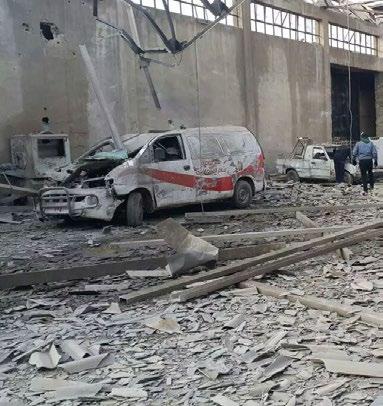
5 Bamber-Zryd, M. (2023). “ICRC engagement with armed groups in 2023.” Humanitarian Law and Policy, ICRC, Geneva.
195 million people across the world live in areas controlled to different degrees by over 450 NSAGs
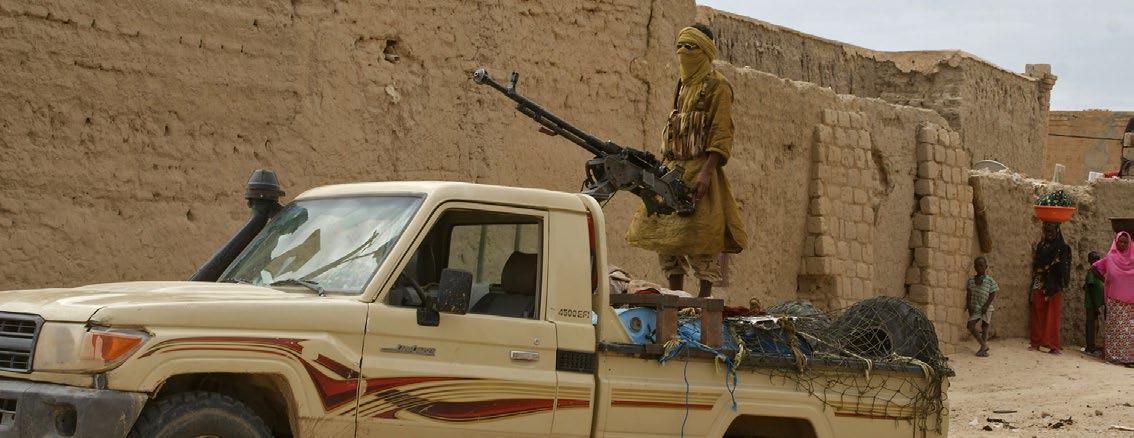
What results from these novel trends and factors is a complex landscape of armed conflicts and violence. Conflicts are not only expanding globally, with

an increasing concentration within fragile countries in Africa and the Middle East, but also marked by the proliferation of multiple NSAGs within a single conflict theatre, for example in Cameroon.6 This proliferation underscores a fragmentation of conflict and violence scenarios, making the formulation and execution of effective responses increasingly challenging.
In Africa, in particular, the virtual absence of centralized insurgencies with a cohesive agenda underpins the fragmentation of security and territorial control on the ground. In the Eastern Democratic Republic of Congo, for example, myriads of NSAGs are dedicated to extractive and rent-seeking activities, exacting a toll on local populations out-
side the purview of the state. In some cases, insurgencies are content with maintaining the status quo, in other areas they pursue limited goals. The common denominator seems to be the abuse and the violence suffered by civilians. Further, in many conflict-affected African countries, central governments are also complicit. They are dominated by political and economic elites that prioritize preserving their power through legalized forms of plunder, rather than enacting meaningful change to address the root causes of conflict.
The outcome is that today conflicts are more protracted than in the past as they extend in duration. Armed conflicts often recur. Increasingly, the same cluster of fragile and conflict-affected countries is resistant to change: they may transition toward peace, but suddenly relapse into conflict. Between 1989 and 2018, nearly half of
all conflicts recurred, and most of the time centered around the same grievances. Protracted conflicts, therefore, become intractable, as conflict resolution initiatives lose legitimacy with both domestic and external actors, while at the same time, they exhibit diminished leverage with conflict parties.
ABOUT THE AUTHOR
Dr. Benjamin Petrini is a Research Fellow at The International Institute for Strategic Studies (IISS), where he conducts research and outreach activities on conflict, fragility and development, with a specific focus on the Africa region. He is one of the principal authors of The Armed Conflict Survey series. Prior to joining IISS, Benjamin worked with the World Bank for over ten years on the responses to fragility, conflict and forced displacement. He was a core team member of the joint United Nations− World Bank Pathways for Peace: Inclusive Approaches to Preventing Violent Conflict (2018). Benjamin holds a PhD from the School of Oriental and African Studies (SOAS, University of London) and an MA from Johns Hopkins School of Advanced International Studies (SAIS) in Washington, DC.

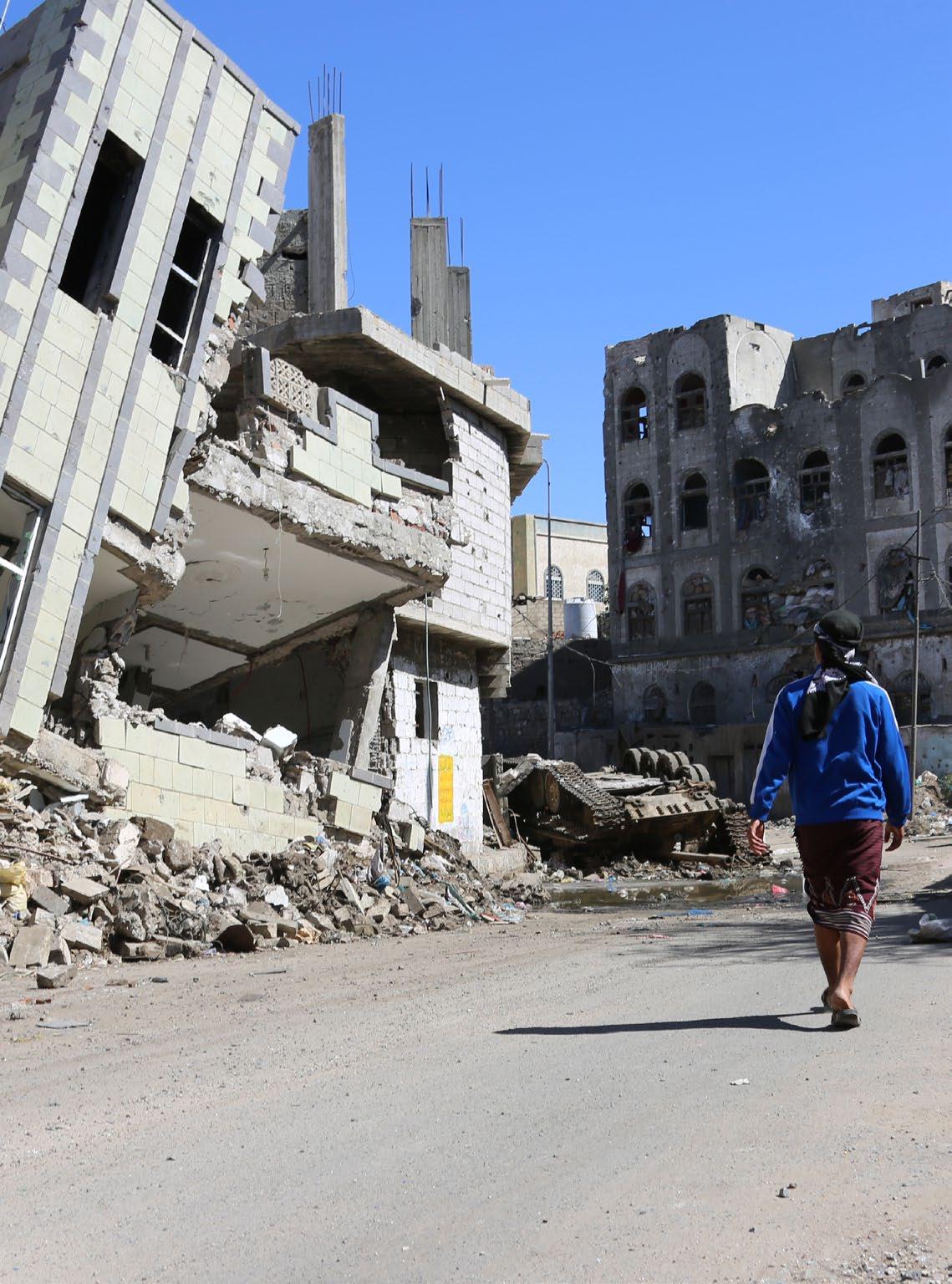
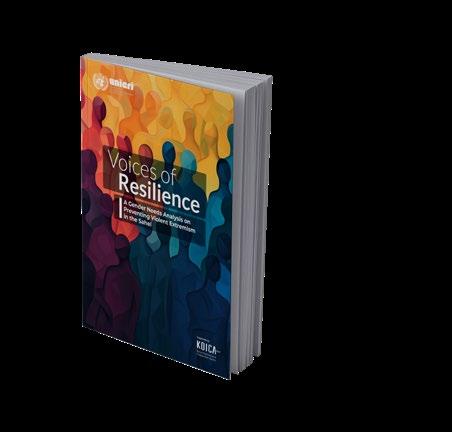


The Sahel represents one of the most unstable areas in sub-Saharan Africa. Widespread violence and limited access to resources, essential services and means of subsistence contribute to increased fragility and impact the everyday life of women, girls, men, and boys. Endemic poverty, inequality –particularly gender inequality – and human rights abuses are among the multiple factors that have a strong impact on the security of the region.

This report explores the intricate relationships between organized crime and terrorism across Latin America. It presents case studies to illustrate the diverse ways in which these connections manifest among various terror and criminal groups throughout the continent. The United Nations Interregional Crime and Justice Research Institute (UNICRI) has conducted ongoing studies which highlight critical issues and cross-regional links, necessitating deeper analysis in other areas such as Africa, the Middle East, and Europe.
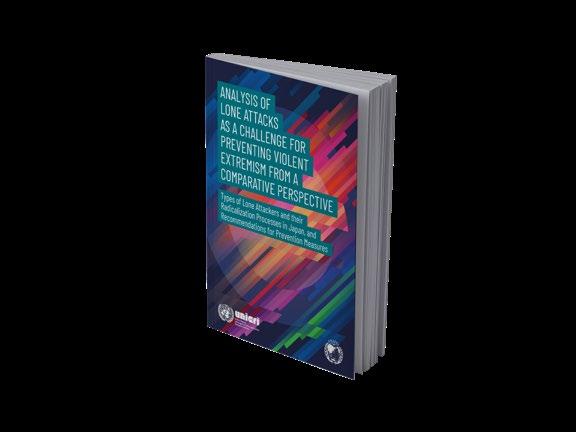
This report, written by Professor Yoshikazu Hamaguchi and Dr. Mana Yamamoto, provides a comprehensive overview of the phenomenon of lone attackers, a critical issue in the landscape of global security, particularly focusing on recent developments in Japan, a nation known for its low crime rates. Despite this, the assassination of former Prime Minister Shinzo Abe on July 8, 2022, by a lone attacker using a homemade firearm, has highlighted the persistent vulnerability to such acts of violence. This event marks a significant point of concern, reflecting a broader global trend of lone attackers who, without direct affiliation to extremist groups or clear ideological motivations, manage to carry out high-impact violent acts.

by Celien De Stercke, Olga Petrovska and Jelle Janssens
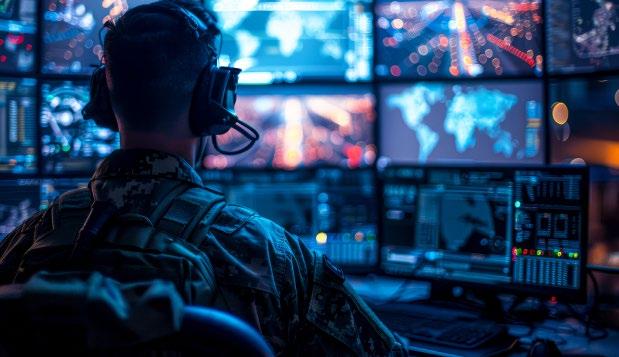
This article draws from the conclusion of the thought-provoking workshop organized by the Ghent University that delved into the increasingly blurred lines between cybercrime and cyberwarfare. As criminal activities in cyberspace begin to mirror those of state-sponsored hacking campaigns, distinguishing between cybercriminals and cyberwarriors becomes more challenging. This workshop, featuring a series of insightful presentations, aimed to explore these complexities and stimulate further research, policy development, and international cooperation in tackling these converging threats.
This article includes insights extrapolated from the presentations of notable experts such as ir. Yvan De Mesmaeker (M.Sc.Eng.), Secretary-General of the European Corporate Security Association (ECSA); Prof. Dr.
Hedi Nasheri, Full Professor at Kent State University; Caroline Frère, Head of the Federal Computer Crime Unit of the Belgian Police (FCCU); Marie Van Hoofstat, Legal Advisor at the Belgian Cyber Command; Celien De Stercke, Doctoral Researcher at Ghent University; Nikolas Ott, Senior Manager of European Government Affairs at Microsoft; and Catherine Piana, Director General of the Confederation of European Security Services (CoESS).
The insights gained from these presentations are instrumental in paving the way for future initiatives and collaborative efforts to secure cyberspace from both criminals and potential warfare activities. This article encapsulates the discussions and conclusions of the workshop, aiming to contribute to the global discourse on these critical issues.

Advanced industrialized nations are at a high risk of being compromised, considering their high levels of digitization and reliance on network storage

Over the past decades, the world has witnessed an unprecedented and transformative wave known as the digital revolution. This seismic shift, propelled by rapid advancements in technology, has fundamentally reshaped the way we live, work, and connect with one another. From the advent of the internet to the proliferation of cyberspace in all its aspects, the digital revolution has not only accelerated the pace of information dissemination but has also blurred the lines between physical and virtual realities, leading to unprecedented innovation and interconnectedness. However, being double-edged in nature, the digital revolution unveils a spectrum of opportunities as well as threats to our 21st century security landscape.
Understanding the intricacies of the security risk landscape - including the threat agents at play, the attack scenarios used, and the assets at risk - is crucial for cultivating a cybersecure world. This comprehensive awareness forms the foundation for developing effective cybersecurity strategies and
Driven by profit motives, cybercriminal activities often align with business principles
implementing proactive measures. By analyzing the motivations and capabilities of threat agents, anticipating potential attack scenarios, and identifying valuable assets that could be targeted, organizations can better prepare to mitigate cyber risks.
Cybersecurity revolves around mitigating intentional or malicious risks orchestrated by individuals or groups with both motivation and capability. Threat agents, with diverse incentives like financial gain, ideological motives, compromised intentions, and egodriven actions, contribute to the complexity of this landscape. This diversity of motivations necessitates a nuanced and adaptive approach to cybersecurity. Government intelligence agencies, organized crime groups, and terrorists stand out in the use of the internet as a strategic tool. These significant threat agents
1
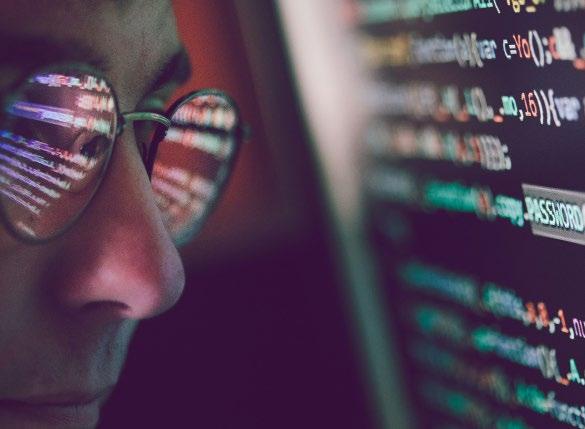
Treating security as a unified entity that connects both cyber and physical worlds is paramount
are each driven by distinct objectives – respectively representing national interests, financial gains, and religious or political beliefs.
The assets at risk in the cybersecurity domain span various crucial components, including Operational Technology (OT) systems, Information Technology (IT) systems, data, business
information, intellectual property, and the overall resilience of organizations. Recognizing these assets is vital for developing effective defense strategies.
“… In a borderless cyberspace of commerce” (Nasheri, 2023, p. 96), it becomes pivotal for governments to proactively secure our digitalized economy, as international security is closely intertwined with economic security. This is essential
for the purpose of establishing reliable trade partnerships amongst nation states. In line with the digital revolution, the same increasing dynamics are observed for all sorts of business data flowing through our vast cyberspace, including intellectual property and trade secrets. As cyberspace enables businesses to operate internationally, so does it facilitate intellectual property theft from various adversaries as well. Advanced industrialized nations are at a high risk of being compromised, considering their high levels of digitization and reliance on network storage. This imposes potential vulnerabilities to every company’s data and as such, poses an open threat to the trade sphere. Even more, this can be reflected on a national security level as well, with critical infrastructure and government officials as the main targets for cyber espionage.
On the other side, nation states and criminal entities engaging in these activities, still need to possess considerable levels of technical proficiency to be effective. The disparity in technical knowledge and skills available on the market, though, can lead to the use of clandestine networks such as the dark web.
2 The following section contains a summary of the presentation by Prof. Dr. Hedi Nasheri, Full Professor at Kent State University. Her presentation was based on her own academic piece ‘State-Sponsored Economic Espionage in Cyberspace: Risks and Preparedness’ (Nasheri, 2023).
‘Trends in cybercrime: business as usual?’ 3
The cybercriminal underworld is marked by a diverse array of activities and trends, necessitating a comprehensive understanding to effectively address the evolving threats in cyberspace. This landscape can be categorized into two key groups: cyber-enabled and cyber-dependent crimes. Cyber-enabled crimes leverage digital tools to facilitate traditional criminal activities, while cyber-dependent crimes operate exclusively in the digital realm. For instance, the contrast between phishing and ransomware represents the spectrum of cybercrime.
Facilitators such as social engineering play a pivotal role, encompassing various methods to manipulate individuals into divulging confidential infor-
mation or compromising security. This human-centric approach often complements technological exploits, forming an integral component of cyberattacks. Moreover, emerging trends like double extortion and re-victimization underscore the adaptability of cybercriminals.
Driven by profit motives, cybercriminal activities often align with business principles, frequently reflect trends in legitimate economies (for example the existence of help desks to assist in ransom payments). The cybercrime ecosystem functions akin to a marketplace, where illicit services, stolen data, and hacking tools are exchanged for financial gain. Understanding this eco -
nomic aspect is crucial in developing effective strategies to disrupt the incentives that fuel the ever-evolving cyber threat landscape.
‘Cybercrime: a tool for plausibly denying cyberwarfare’4
The convergence of the economic criminal underworld and the demand for specialized cyber skills of some nationstates has given rise to the phenomenon of cyber proxies. These proxies act as intermediaries, bridging the gap between sophisticated cyber capabilities and the strategic objectives of states lacking the requisite technical expertise.
The convergence of human security skills with the digitalized sphere is necessary to effectively prevent cyberattacks

3
4 The following section contains a summary of the presentation by Marie Van Hoofstat, Legal Advisor at the Belgian Cyber Command.
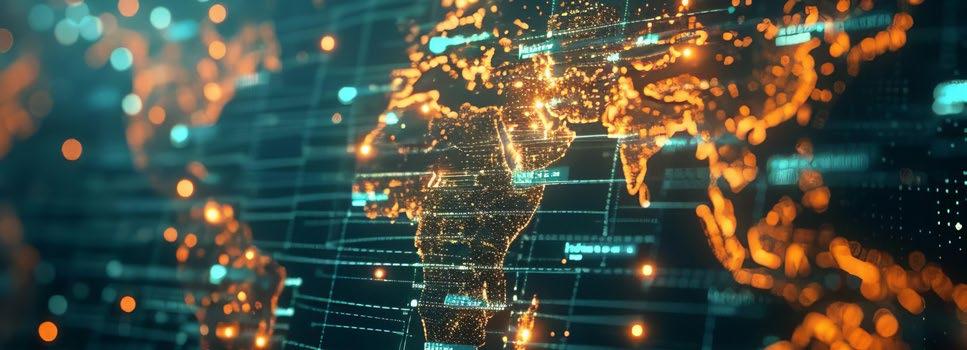
These dynamics have compelled military intelligence services to extend beyond traditional domains. While cybercrime might not fall explicitly under their purview, the intricate nature of contemporary cyber threats, such as the use of cyber proxies, has compelled military intelligence to adapt to these evolving challenges.
The observed collaborations between cybercriminals and foreign intelligence services have implications that transcend conventional legal boundaries. Instances where governmental cyber units disguise their malware or ransomware, foreign intelligence units employ ransomware-as-a-service from criminals to obfuscate their operations, or even state units collaborate with cybercriminals to conduct attacks, highlight the complex interplay between state-spon -
sored activities and cybercrime. The primary focus of military intelligence services in cyberspace revolves around geopolitical interests such as cyber espionage, cyber sabotage, and cyber subversion. Seeking to engage in cyber activities while maintaining a degree of plausible deniability, cyber proxies become a potent tool for nation-states around the globe.
‘Cyberspace’s grey frontiers x digital information’ 5
As the lines between cybercrime and state-sponsored cyber activities continue to blur, there is a pressing need for legal frameworks and international agreements to govern these operations and ensure accountability in the complex realm of cyberspace. Therefore, the question arises whether it is possible to cate -
gorize the phenomenon of cyber proxies among cybercrime or cyberwarfare. This classification is critical as it dictates the governance frameworks needed to address and mitigate these threats. Virtual clues, such as the strategic nature of the code, the sophistication of the attack, and links for attribution, offer valuable insights into intent, state-affiliation, and directness.
The open and active cybersecurity industry plays a pivotal role in extracting this information, emphasizing its growing significance in shaping cyber governance architectures. The ability to decipher the characteristics of cyber activities through virtual clues allows for a more nuanced understanding, enabling policymakers and security experts to tailor responses and strategies that address the complex and evolving nature of cyber
5 The following section contains a summary of the presentation by Celien De Stercke, Doctoral Researcher at Ghent University.
threats. As the lines between cybercrime and cyberwarfare continue to blur, effective governance frameworks become increasingly crucial in safeguarding digital landscapes.
‘Cyber threat landscape unveiled: insights from industry on creating a more resilient cyber ecosystem’ 6
A prime example of an industry leader in the international cybersecurity architecture is Microsoft. Through vigilant tracking of the evolving threat landscape, Microsoft has demonstrated a comprehensive understanding of cybersecurity challenges posed by both state and criminal actors. The company has noted a discernible trend in nation states increasingly employing cyber operations to advance their geopolitical objectives, with a heightened focus on critical infrastructure and cyberespionage activities.
Additionally, a notable disparity between corporations was highlighted as well. Whereas large companies in advanced
industrialized nations are increasingly adept at protecting themselves, smaller businesses grapple with increasing cyber threats due to limited resources and awareness. Addressing this divide within our fragmented digital landscape poses an international challenge. Targeted efforts are required to raise awareness and provide affordable solutions, ultimately enhancing cybersecurity practices for smaller enterprises.
The tech giant’s commitment to cybersecurity extends beyond technological solutions, as evidenced by its pioneering role in international digital diplomacy. Microsoft’s call for a formal Digital Geneva Convention in 2017 underscores its dedication to establishing international norms and regulations in the cyberspace domain.
As the lines between cybercrime and cyberwarfare continue to blur, effective governance frameworks become increasingly crucial
As multinational companies become frontline entities in the digital revolution, their role in cybersecurity architectures becomes indispensable for fostering a secure international environment. Microsoft’s efforts exemplify the importance of collaboration, information sharing, and diplomatic initiatives to address the complex and global challenges posed by cyber threats.
‘Towards a holistic approach to cyber and physical security in critical infrastructure’
7
Within this line of reasoning, the holistic approach advocated by the Confederation of European Security Services (CoESS) underscores the interconnected nature of security, particularly in the context of critical infrastructure. The acknowledgment of the intertwining of physical and cybersecurity is crucial, as breaches in one domain can cascade across various security facets. Despite this interdependence, the current handling of physical and cybersecurity often occurs in silos and overlooks the human factor as a constant vector in the threat landscape
6 The following section contains a summary of the presentation by Nikolas Ott, Senior Manager European Government Affairs at Microsoft. His presentation was informed by Microsoft’s latest ‘Digital Defense Report’ (2023).
7 The following section contains a summary of the presentation by Catherine Piana, Director General of the Confederation of European Security Services (CoESS). Her presentation was found on a recently published report by CoESS and International Security Ligue (2023): ‘Cyber-Physical Security and Critical Infrastructure. Protecting nations and societies in the era of connected systems and hybrid threats.’
- whether involuntary or malicious. The convergence of human security skills with the digitalized sphere is necessary to effectively prevent cyberattacks. Recognizing that a wider field of competence leads to more effective security solutions, this approach aims to bridge the identified gap.
Moreover, private security companies operate across a diverse range of services in the entire security value chain, facing challenges in providing holistic solutions. However, they play a pivotal role in addressing the multidimensional nature of security threats by enhancing security management protection. Treating security as a unified entity that connects both cyber and physical worlds is paramount. In this way, coordination can be improved, security risks can be reduced and unified targets aligned. By viewing security as an integrated discipline, private security companies contribute significantly to the overall resilience of critical infrastructure in an interconnected and complex security landscape.
The seminar on ‘Cybercrime & Cyberwarfare: Entering the Grey Zone’ highlighted the intricate nature of cyber operations, revealing a blurred line between cybercriminals and cyberwarriors within this grey frontier.
Understanding the security risk landscape is crucial, involving the analysis of threat agents, attack scenarios, and assets at risk. The motivations and capabilities of diverse threat agents - including government intelligence agencies, organized crime groups, and terroristscontribute to the complexity of the cybersecurity domain. The assets at risk span crucial components such as critical infrastructure, OT systems, IT systems, data, business information, intellectual property, and overall organizational resilience.
A comprehensive understanding of the cybercriminal underworld, categorized into cyber-enabled and cyber-dependent crimes, is vital. Social engineering and emerging trends like double extortion and re-victimization underscore the adaptability of cybercriminals, who often operate within an economic framework that mirrors legitimate economies.


The diversity of the threat landscape makes advanced industrialized nations particularly vulnerable, yet it also opens a wide range of geopolitical opportunities. Cyberespionage, cyber sabotage, and cyber subversion are strategic methods in achieving geopolitical objectives. However, the cyber arena demands specialized skills and knowledge, not always available in the competitive market. So much so that nation-states have been observed instrumentalizing the criminal underworld to conduct plausibly deniable cyber operations. As such, the uneven distribution of advanced technical skills prompts the strategic use of crime as a tool for plausible deniability, rendering the criminal underworld a covert ally in the digital battlefield. Therefore, cybercrime can pose a significant threat to (inter) national security.
In order to counter these challenges, this complex threat landscape should be reflected in the governance architectures. Collaborative efforts, strategic partnerships, vigilant monitoring, and holistic approaches that span both cyber and physical domains are emphasized. Furthermore, the interplay between physical and cybersecurity should be recognized, particularly in the context of critical infrastructure, where a breach in one domain can have cascading
effects across various facets of security. The convergence of human security skills with the digitalized sphere is necessary to effectively prevent cyberattacks.
Our interconnected world furthermore puts novel actors within the frontline of our digital space, such as private security companies and digital service providers. Private security companies, operating across the entire security value chain, play a pivotal role in addressing the multidimensional nature of security threats, by enhancing security management protection. Whereas multinational service providers become firstline responders in the digital landscape. This highlights the need for collaboration, information sharing, and diplomatic initiatives as central features in addressing the complex and global challenges posed by cyber threats.
The digital revolution unveils a spectrum of opportunities as well as threats to our 21st century security landscape

Moreover, prioritizing cybersecurity education and awareness becomes crucial to empower individuals and organizations against evolving threats. Legal actions and diplomatic initiatives are integral components of this comprehensive strategy, providing a framework to hold perpetrators accountable and foster international cooperation.
While recognizing the potential threats posed by emerging technologies such as artificial intelligence (AI), it is imperative to view them as opportunities to counteract evolving challenges effectively. Employing AI can enhance our capabilities to safeguard against sophisticated adversaries.
It is essential to acknowledge that whilst cybersecurity is pivotal, it represents just one facet of the broader security landscape. A comprehensive security strategy must be adopted that considers multiple attack vectors, recognizing that cyber threats are interconnected with physical, personnel, and procedural vulnerabilities.
Lastly, academia aims to address the gaps identified and can act as a bridge, seamlessly weaving together the scattered insights gathered from various actors in the cyber landscape. In the ever-evolving realm of cybersecurity, interdisciplinary research becomes a powerful force capable of harmonizing diverse perspectives and enhancing our understanding
of the interconnected challenges at hand.
In conclusion, these insights underscore the need for coordinated and holistic strategies to address the evolving challenges at the intersection of cybercrime and cyberwarfare. Collaboration, international cooperation, legal actions, cybersecurity education, and research are crucial components in navigating the complexities of the digital landscape. Navigating this hybrid world requires a delicate balance, harnessing opportunities while mitigating associated risks, as society grapples with the complexities of an increasingly interconnected and technologically driven world.
Confederation of European Security Services & International Security Ligue (CoESS). (2023). Cyber-Physical Security and Critical Infrastructure. Protecting Nations and Societies in the Era of Connected Systems and Hybrid Threats. In Confederation of European Security Services https://www.coess.org/newsroom.php?page=white-papers
De Mesmaeker, Y. (2024). Internet as a Weapon [Presentation]. Cybercrime & Cyberwarfare: Entering the Grey Zone (Ghent University - 8th of February), Ghent, Belgium.
De Stercke, C. (2024). Cyberspace’s Grey Frontiers x Digital Information [Presentation]. Cybercrime & Cyberwarfare: Entering the Grey Zone (Ghent University - 8th of February), Ghent, Belgium.
Frère, C. (2024). Trends in Cybercrime: Business as Usual? [Presentation]. Cybercrime & Cyberwarfare: Entering the Grey Zone (Ghent University - 8th of February), Ghent, Belgium.
Microsoft Digital Defense Report 2023 (MDDR) | Microsoft Security Insider. (2023). https://www.microsoft.com/en-us/security/security-insider/microsoft-digital-defense-report-2023
Nasheri, H. (2023). State-Sponsored Economic Espionage in Cyberspace: Risks and Preparedness. In Springer eBooks (pp. 87–107). https://doi.org/10.1007/978-3-031-29107-4_5
Nasheri, H. (2024). Challenges & Threats of Economic Cyber Espionage [Presentation]. Cybercrime & Cyberwarfare: Entering the Grey Zone (Ghent University - 8th of February), Ghent, Belgium.
Ott, N. (2024). Cyber Threat Landscape Unveiled: Insights from Industry on Creating a More Resilient Cyber Ecosystem [Presentation]. Cybercrime & Cyberwarfare: Entering the Grey Zone (Ghent University - 8th of February), Ghent, Belgium.
Piana, C. (2024). Towards a Holistic Approach to Cyber and Physical Security in Critical Infrastructure (and Everywhere Else) [Presentation]. Cybercrime & Cyberwarfare: Entering the Grey Zone (Ghent University - 8th of February), Ghent, Belgium.
Van Hoofstat, M. (2024). Cybercrime: A Tool for Plausibly Denying Cyberwarfare [Presentation]. Cybercrime & Cyberwarfare: Entering the Grey Zone (Ghent University - 8th of February), Ghent, Belgium.
Celien De Stercke is a Criminologist at Ghent University’s Institute for International Research on Criminal Policy (IRCP) pursuing a PhD on the phenomenon of cyber warfare.
Olga Petrovska is EU-intern at the interdisciplinary research consortium IDC Crime, Criminology and Criminal Policy (Ghent University).
Jelle Janssens is an associate professor at the Department of Criminology, Criminal Law and Social Law of the Faculty of Law and Criminology (Ghent University) and a member of the Institute of International Research on Criminal Policy (IRCP).
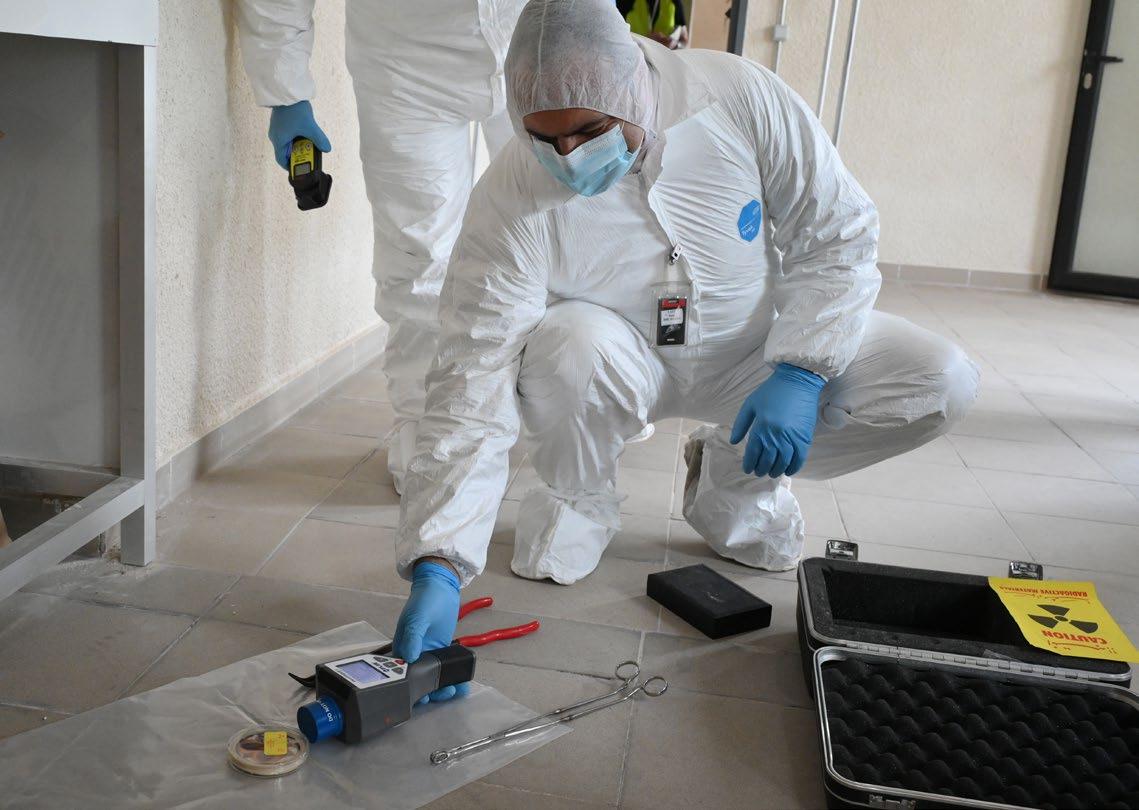
by Rana Baydoun
During the last decade, there has been a notable rise in the awareness of chemical, biological, radiological and nuclear (CBRN) threats due to documented incidents occurring in recent years. The use of CBRN agents by terrorist groups in a specific region not only poses a direct threat to those regions but also raises concerns about the potential for such tactics to be employed in other parts of the world.
Given the potentially catastrophic consequences of a CBRN incident, national and international organizations have been actively investing in capacity building and collaborative efforts to enhance the capabilities to prevent, detect, and respond to
such threats. The field exercises are part of a broader strategy to mitigate CBRN risks posed by terrorist organizations seeking to exploit CBRN materials for malicious purposes.
In this context, and within the framework of the European Union Chemical, Biological, Radiological and Nuclear Centres of Excellence Initiative (EU CBRN CoE), Lebanon drafted the National Action Plan (NAP) and reviewed it in 2022. This strategic document identifies risks, capabilities, gaps and actions to be taken in the field of CBRN risk mitigations. In line with the NAP, Lebanon implemented a series of activities that started with ARZ 2021, a

field exercise addressing CBRN counter-terrorism, conducted from 06-09 December 2021. A preparatory field training and planning conference, ARZ 2023, took place on 23-24 May 2023.
From 04-07 March 2024, the ARZ 2023 Field Exercise to Counter CBRN Terrorism was conducted, under the patronage of the Lebanese Prime Minister and the leadership of Lebanon’s National CBRN Coordinator, Dr, Bilal Nsouli. The exercise was initially planned for October 2023 but was postponed due to the recent prevailing situation in the Middle East region. The field exercise is called ARZ, in reference to the Cedar tree, a
During the last decade, there has been a notable rise in the awareness of chemical, biological, radiological and nuclear (CBRN) threats
Lebanese symbol reflecting the strength of the national authorities who have demonstrated commitment and resilience in responding to numerous challenges the country has faced over the past years, including the economic crisis, the COVID-19 Pandemic, Beirut port explosion and recently
ARZ 2023 was implemented within the framework of EU CBRN CoE, funded by the Service for Foreign Policy Instruments (FPI) of the European Commission. It was co-organized by the United Nations Interregional Crime and Justice Research Institute (UNICRI) and the On-Site Assistance Expert for the Middle East Regional Secretariat (CBRN CoE Project n. 94). It was also supported by and designed in close coordination with the International Science and Technology Center (ISTC) and the CoE Projects n. 73 “Protection of Critical Infrastructures” and CoE Project n.
97 “Improvement of the Chemical Security and Safety in the Middle East.” The exercise was rolled out over two consecutive full days (05 and 06 March), while 04 March was dedicated to preparatory meetings between evaluators and team leaders, including safety and security briefings. The 7th of March was reserved for the official closing ceremony.
ARZ 2023 is an important tool to test national capabilities to respond to CBRN emergencies, identify gaps for improvement, and specify needs to be addressed. Its main objectives are to test and foster existing CBRN Standard Operating Procedures (SOPs), including interagency coordinating measures, VIP protection capabilities in a complex CBRN environment, medical treatment capacities after CBRN incidents (with a focus on mass casualties), and capacities in sampling and identifying CBRN materials, taking into consideration forensic aspects to counter terrorist networks.
Two hundred and seventy participants from national authorities responding to CBRN emergencies, including incidents triggered by terrorist attacks, took part in the exercise. These key Lebanese institutions include the Lebanese Armed Forces, Internal Security Forces, Beirut Fire Brigade, Civil Defense, Lebanese Red Cross,

ARZ 2023 stands as a testament to international collaboration and shared commitment in building resilience against CBRN threats
and Lebanese Atomic Energy Commission. The assigned role of each institution in such an event is consistent with the legal texts governing their work and according to the SOPs.
ARZ 2023 was composed of 7 consecutive scenarios with a narrative sequence. All injects were assessed by a team of international evaluators, coordinated by a CBRN expert from the Italian Ministry of Foreign Affairs and International Cooperation. The team was composed of members from the
Austrian Armed Forces/On-Site Assistance Expert for the Middle East, French Police (France), Guardia Civil EUROGENDFOR (Spain), the International Criminal Organizations (INTERPOL), the Italian Army, the Organization for the Prohibition of Chemical Weapons (OPCW), UNICRI, and the Iraqi Ministry of Interior.
Several observers joined the exercise, including representatives from the European Union (EU), the European Commission (EC), the League of Arab States, the United Nations Office on Drugs and Crime (UNOCT), the United Nations Office for Disarmament Affairs (UNODA), expert delegates from countries cooperating with Lebanon in CBRN issues (Oman, United States), delegates from partner countries of the EU CBRN CoE initiative,
implementers of relevant projects, and selected representatives of foreign missions present in Lebanon.
ARZ 2023 stands as a testament to international collaboration and shared commitment in building resilience against CBRN threats. The successful execution of this exercise in Lebanon, in this challenging period highlighted the dedication and commitment of the Lebanese Team and the EU CBRN CoE to mobilize efforts in the field of CBRN risk mitigation.
Special thanks to the On-Site Assistance Expert for the Middle East Regional Secretariat, Col Günter Povoden for the efforts in assisting the Lebanese team during all phases of ARZ 2023, and to Col. Andrea Gloria for his effort in coordinating and preparing the whole evaluation process.
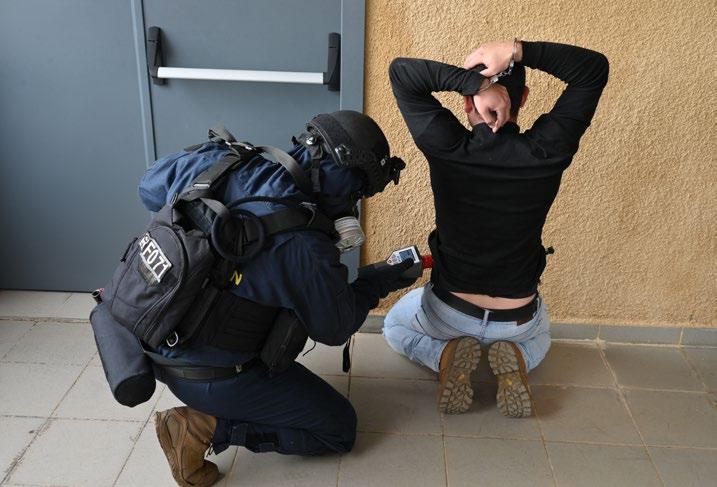
Rana Baydoun is currently serving as a Researcher at the Environmental Radiation Control Department- Lebanese Atomic Energy Commission, National Council for Scientific Research. Previously she was Acting Programme Management Officer and EU CBRN CoE Regional Coordinator for the Middle East. In this role, she coordinates and implements activities and projects within the EU CBRN CoE initiative, focusing on CBRN risk mitigation.
With 25 years of experience at the Lebanese Atomic Energy Commission, Rana has specialized in nuclear security, radiological and nuclear emergency management, and the design and implementation of technical cooperation projects with the International Atomic Energy Agency (IAEA).
She has authored more than 25 publications in international journals and proceedings of international conferences, covering the application of nuclear techniques in environmental studies and cultural heritage valorization, as well as CBRN safety and security. She holds a PhD- Environmental Chemistry.
by Monalisa Hazarika, United Nations Youth Champion for Disarmament

Former United Nations (UN)
Secretary-General Kofi Annan’s statement on small arms as the “real weapons of mass destruction” is no exaggeration and holds true given their perpetual use in both wartime and peacetime situations. While not capable of obliterating entire cities in just one second, they are known to cause, what is referred to as “individual destruction,” given their cross-sectional and mutually reinforcing relation with organ-
ized crime, terrorism, gender inequality, and human rights violations. This posits them at the intersectional priority of arms control and disarmament, violence prevention, human rights and humanitarian law, public health, economic development, post-conflict reintegration, Sustainable Development Goals (SDGs), terrorism, and criminality — each perspective advancing a differing lens and solution.

SALWs have a disproportionate impact on young people. They are both victims and perpetrators of armed violence

Small arms and light weapons (SALW) are lethal, easy to use, and difficult to trace when not properly marked and without recordkeeping and tracing capacities by national authorities
Small arms and light weapons (SALW) are lethal, easy to use, and difficult to trace when not properly marked and without record-keeping and tracing capacities by national authorities. Given the relative ease of concealment, transport and maintenance, they remain in circulation for long and are available across gray, white, and black markets. Often a politically contentious issue, they are wielded as tools to undergird and maintain power. While a legitimate tool for state security, their illicit and licit production, proliferation and misuse have presented a novel set of issues, with their widespread availability being only
one part of the problem. Besides their licit industrial counterparts, a fraction of these weapons are privately manufactured outside authorized production hubs or are craft-produced with crude materials.
While their direct effects — facilitating and exacerbating armed conflict, committing serious human rights violations, hindering humanitarian assistance operations, and weakening governance and the rule of law — are stipulated in policy considerations, their cumulative indirect impacts are harder to measure and assess. This includes an array of opportunity costs incurring from overburdening medical systems, privatization of violence, brewing gun
culture, large-scale refugee flow, divestment on economic fronts, and a culture of impunity. In response, they are regulated under differing national norms that modulate their possession, manufacture, transfer, and use and are well within the scope of existing multilateral treaties, instruments and regional arrangements. Further, reporting on their management and tracing is included in the UN Programme of Action to Prevent, Combat and Eradicate the Illicit Trade in SALW, and specific information on their transfers is specified in UN Commodity Trade Statistics Database (COMTRADE) and UN Register of Conventional Arms (UNROCA) databases to promote transparency and accountability among states.
SALWs have a disproportionate impact on young people. They are both victims and perpetrators of armed violence, and through their association with armed groups, who recruit them as human shields and combat roles, they are chronically persecuted, displaced, deprived of access to services, and subjected to the invisible effects on their psychological and social behavior. An inde -
pendent progress study on the co-relations between youth, peace, and security conducted in 2018 documented the exclusionary practices of youth as a form of “structural and psychological violence that is deeply rooted in the reciprocal mistrust between young people, their governments, and the multilateral system.” This, according to the report, mani-
fests across six core areas of political and economic exclusion, education, gender, injustice and human rights, disengagement, and reintegration.
As future custodians of our collective vision, youth have the most to lose should the current crisis continue unabated making it imperative to not just “work for” but “with youth”
Representing a quarter of the world’s population, we currently have the largest generation of young people in history at around 1.8 billion and are an intersectional priority of the 2030 Agenda for Sustainable Development . As future custodians of our collective vision, youth have the most to lose should the current crisis continue unabated making it imperative to not just “work for” but “with youth.” With little influence over the decision-making process, they have been vocal about their frustrations with current arrangements which merely aim at appeasing their views.

Representing a quarter of the world’s population, we currently have the largest generation of young people in history at around 1.8 billion
As advocates and campaigners for peace, youth are referred to as the “torchbearers” of the Sustainable Development Goals and are involved at various levels of awareness-building. By engaging them as “partners for peace,” they help inspire others to exercise their right to freedom of information, opinion, expression, association, and assembly, both on digital platforms and offline. So far, young people have proved their passion for the cause of disarmament by working at the forefront of successful international campaigns to ban landmines, cluster munitions, and nuclear weapons, which prompted the UN Secretary-General Antonio Guterres to acknowledge youth as the “ultimate force for change” in his Agenda for Disarmament.
As changemakers and visionaries, youth, by including disarmament-related considerations in their academic work and
research, can discover ways to engage in scholastic engagements with their peers. This will help them determine challenges and opportunities and devise avenues to meaningfully respond. They could create or join groups, societies, and clubs that explore the intersectionalities of disarmament and arms control with various societal issues and find synergies that they relate to the most. Also, by taking the lead in establishing regional and global networks around disarmament and security issues, they can fill in the gap where such groups do not exist. Understanding where their professional trajectory and work-
stream intersect with disarmament and related international security issues will enable them to visualize and modulate the interlinkages into their interest areas and make multifaceted contributions.
By taking the lead in establishing regional and global networks around disarmament and security issues, they can fill in the gap where such groups do not exist

In recent years, there has been a pragmatic shift in the understanding of who young people are and their role in policy and decision-making processes. However, much is yet to be done to provide meaningful space for youth to respond across research, policy, and advocacy spheres. Instead of creating separate avenues and ad hoc committees for their participation, arrangements should be made to integrate them into the existing workforce, where they work and
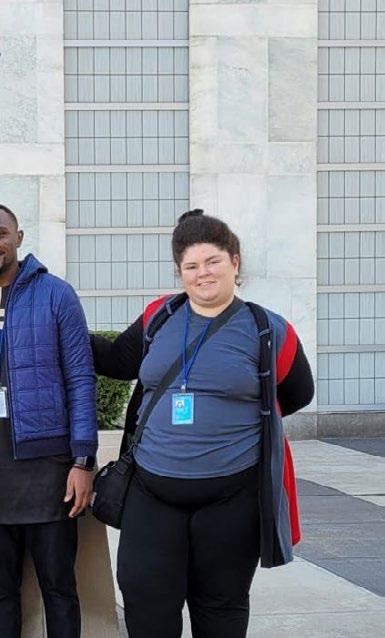
learn alongside experienced professionals. The inclusion of youth perspectives should be treated as more than just an indicator of diversity and as a precursor to the term “human security.” Having a young workforce would not only address power imbalances and geographical biases but could potentially help reshape how traditional security is conceptualized.
Funding and institutional support remain a significant constraint for youth that undermines their involvement, which may manifest as nationality-based restrictions on applications, visa denials, or a lack of full-ride scholarships. Reviewing youth mainstreaming policies requires intentional and concerted efforts from a wide spectrum of actors, which will help understand the barriers to their participation, retention, and advancement. Further, taking stock of the role of youth in preventing SALW violence can help assess the efficacy of existing initiatives and
evaluate gaps for future strategies and plans of action.
There has been a growing recognition by states of the integral role of youth reflected in international resolutions, initiatives, and resources dedicated to promoting the participation of young people in discussions around disarmament, non-proliferation, and arms control, including UNODA’s #Youth4Disarmament Initiative, Youth 2030 Strategy, Young Women in Non-Proliferation and Disarmament (YWNPD) Mentorship Programme, and UNSC resolutions 2250, 2419, and 2535, to name a few. Despite the lack of meaningful participation around small arms control at the institutional level, a report by IANSA listed #SouthSudanIsWatching (South Sudan), the National Youth Jirga Forum (Afghanistan), and the Youth for Change and Conflict Reduction Program (Colombia) as successful grassroots movements led by youth.
They could create or join groups, societies, and clubs that explore the intersectionalities of disarmament and arms control

By recognizing young people as equal stakeholders and injecting greater attention into their training, education, and capacity building, states, civil society, and institutions can move beyond involving youth as mere tokenism. Having a repository of financial and other forms of assistance for youth-led or youth-focused initiatives focused on small arms control and providing space for youth-led interventions in national and international arenas can help tackle the manifested structural inequities and implement transparent and equitable laws to reduce the scourge of arms in our societies and save lives.
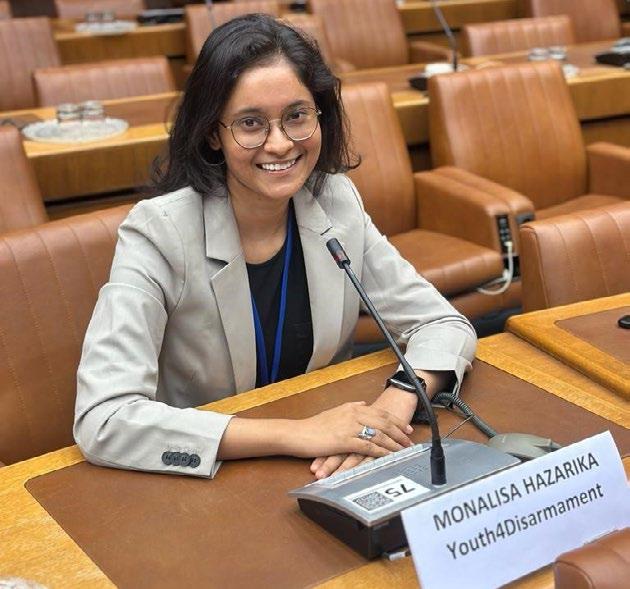

These testimonies were contributed by participants from United Nations Office for Disarmament Affairs (UNODA)’s flagship youth engagement initiatives: the UN Youth Champions for Disarmament Training Programme and the Youth Leader Fund for a World Without Nuclear Weapons

Jutomue Doetein (he/him), 23 from Liberia UN Youth Champion for Disarmament
Young people, comprising nearly 1.8 billion individuals globally (United Nations, 2023), are disproportionately affected by the devastating impact of small arms and light weapons (SALW) violence. To meaningfully engage youth in SALW control policy and decision-making processes, we must first recognize their potential as agents of change.
Initiating community-led engagement activities, seminars, and innovative events focused on educating youth about the dangers posed by SALW is crucial. Moreover, fostering intergenerational dialogue ensures that youth per-
spectives are heard and valued in policy discussions. Flexible grants should be provided to empower young leaders to advocate for the effective implementation of government policies.
In conclusion, by involving youth in SALW control policy, we harness their creativity and passion to advocate for safer communities and realize their dreams, free from the threat of armed violence.



Meaningfully involving youth in small arms and light weapons control policy and decision-making processes requires focusing on education, empowerment, and equality.
Firstly, the authorities and civil society should form education networks that bridge the gap in education between privileged and underprivileged groups to ensure that youths from different backgrounds have a common understanding and knowledge of the issue.
Secondly, stakeholders should establish and support youth platforms to empower young people to share perspectives
and contribute their knowledge to the policy process.
Thirdly, all stakeholders must emphasize equality. Youths, regardless of gender or race, must be treated respectfully as adults.
Lastly, using offline and online approaches with youth is important because there is still a digital divide in some communities. Adults should use this opportunity to build capacity in digital literacy for underprivileged groups who have less access to technology.


Rohleder (she/her), 20 from
To meaningfully involve youth, it is first vital to provide spaces for their voices to be heard. Education campaigns are essential in getting youth involved and knowledgeable about these topics, but to actually keep them engaged, it is important to have accessible platforms for youth to share their voices and collaborate with each other.
When it comes to involving youth in Small Arms and Light Weapons control policy and
decision-making transparency is also key, to have information widely accessible to youth so that they can know current situations and where to direct their efforts. It is also essential to help youth develop skills to effectively contribute to policy and decision-making processes. Without those skills it can be hard for youth to know what their involvement can look like as well as how to create change and lead other youth to do the same.


by Eli Horton, UNODA’s Youth4Disarmament Member
2023 brought Cold War anxieties and Robert Oppenheimer’s legacy to the big screen with the two most recent portrayals of nuclear weapons issues in popular culture. While timely reminders of the threat of nuclear weapons will fade from the spotlight, the imperative work of engaging young people in nuclear non-proliferation to secure a peaceful future remains.
Generation Z’s social and political engagement in movements to secure a safe and stable future for humanity is cause for a great deal of optimism. Tens of thousands of our peers gathered in Scotland to demand climate legislation,
Qatari youth leaders have banded together to shape environmental policy, and young leaders in the United States won legislative battles in Montana and Hawai’i. Our generation is taking great strides to translate our visions for a better world into concrete demands and encouragement of our political leaders.
Our generation’s response to the threat of 13,000 nuclear weapons is of equal stakes for our planet and all life upon it, but more work remains for younger generations to tackle nuclear arms with the same organization and urgency as the climate crisis.

Our generation is taking great strides to translate our visions for a better world into concrete demands and encouragement of our political leaders.
The UN Youth Champions for Disarmament , the Youth Leader Fund for a World Without Nuclear Weapons, and the Hiroshima G7 Youth Summit are recent initiatives providing a platform for young people to actively participate to curtail nuclear weapon arsenals. These efforts aim to make our societies more peaceful, sustainable, and equitable. Additionally, demonstrating how those goals are interlinked with other security issues can further mainstream support for nuclear disarmament and non-proliferation.
By drawing on the strategies and tactics of the climate movement, we can sharpen our collective vision of a nuclear-weapon-free future and nurture a larger, younger, and more inclusive community of advocates.
Our generation has stepped up to tackle the climate crisis when we learned that its dangers are both urgent and personal to each of us. That was not enough; however, we also needed meaningful opportunities to respond. The movement for nuclear disarmament and non-proliferation can
extend its reach by building on meaningful programs to reach underrepresented groups of young people. Reverse the Trend and Youth for TPNW provide fora for youth to make their voices heard on the importance of nuclear non-proliferation and disarmament. The sustained effort of initiatives such as the Young Women in Non-Proliferation and Disarmament Mentorship Programme and the establishment of new chapters, opportunities, and networks will be critical in equipping our generation with the context they need to engage deeply on nuclear disarmament and non-proliferation issues.
Generation Z’s social and political engagement in movements to secure a safe and stable future for humanity is cause for a great deal of optimism.
Around the world, young climate activists are energizing their peers by explaining how their causes are part of a broader struggle for social and
economic justice. Likewise, we can achieve progress for nuclear disarmament and non-proliferation by fully educating our peers about the ways that nuclear weapons harm marginalized groups and the environment. The social and racial injustices of uranium mining and nuclear testing and the intersection of gender and nuclear weapons expand the reach of nuclear non-proliferation and disarmament to diverse communities. Presenting security issues as social injustices has resonated with youth for generations and is successfully taking hold today. By continuing to shift conversations around nuclear disarmament and non-proliferation towards social justice considerations, thoughtful leaders of all ages can help our generation effectively channel its determination to achieve a more peaceful, fair, and sustainable future for us all.
The social-media landscape has transformed how members of our generation organize and build their influence. Young activists can not only share messages and posts that spread quickly to millions but also employ advanced metrics to easily compare how well their ideas are gaining traction among different groups of
people. The commercial and critical success of Christopher Nolan’s Oppenheimer provided the opportunity for organizations to promote nuclear non-proliferation and disarmament through social media channels. The Nuclear Threat Initiative’s Make Nukes History is a powerful campaign that complemented the 2024 Academy Awards to emphasize that the nuclear threats of the Cold War remain with us today.
Venessa Hanson, the Social Media Project Officer at the International Campaign to Abolish Nuclear Weapons, is one of the pioneers now using Instagram and TikTok to present our generation with nuanced, compelling arguments for nuclear disarmament. She and others are demonstrating that social media platforms, which are already being used to great success in response to the climate crisis, still have tremendous potential to help us tackle the threat of nuclear weapons.
As the some of the first “digital natives”, members of Generation Z enjoy the best access to information of any group in history. If we draw lessons from the climate movement and continue to organize, our generation can produce the most diverse and effective leaders for nuclear disarmament and non-proliferation the world has yet seen.



Our generation has stepped up to tackle the climate crisis when we learned that its dangers are both urgent and personal to each of us.
These testimonies were contributed by participants from United Nations Office for Disarmament Affairs (UNODA)’s flagship youth engagement initiatives: the UN Youth Champions for Disarmament Training Programme and the Youth Leader Fund for a World Without Nuclear Weapons


Donovan Kelso (he/him), 24 from New Zealand – participant in the Youth Leader Fund for a World Without Nuclear Weapons
To be young today is to live and breathe information. But having the world at your fingertips is a double-edged sword. While it offers incredible potential for change, coming face-toface with the scale of global challenges can be paralyzing. I see too many people in my community who find it easier not to care than to fail to make a difference. All the information in the world, and what we have learned is hopelessness, powerlessness, and apathy.
Young people need to know that there is power in our voices and meaning in our action. If you want young people to believe in a world without nuclear weapons, show us that the world is willing to let go of them. Show us that we have the power to be heard above the centuries of history of violence and conflict. Show us that when we speak, people will listen.

Ly Quoc Thai (he/him), 23 from Vietnam - participant in the Youth Leader Fund for a World Without Nuclear Weapons
In the age of information, Generation Z has risen to confront the urgent and personal dangers posed by rapid nuclearization. However, meaningful opportunities are essential to catalyze action. The movement for nuclear disarmament and non-proliferation can broaden its impact by leveraging successful programs that engage underrepresented youth.
Initiatives like UNODA’s Youth Leader Fund for A World Without Nuclear Weapons help empower students, think

tanks, and young enthusiasts in grasping the historical and ongoing efforts to eliminate and prevent the spread of weapons of mass destruction. Expanding such initiatives, along with providing new and sometimes overlooked new perspectives on the impacts posed by nuclear weapons, is crucial in providing Generation Z with the necessary understanding and motivation to actively participate in nuclear disarmament and non-proliferation efforts.
Hree Samudra (she/her), 24 from Indonesia – participant in the Youth Leader Fund for a World Without Nuclear Weapons
To energize Gen Z for a world without nuclear weapons, we must leverage the platforms and mediums they resonate with. This involves creating engaging, shareable content on social media, utilizing storytelling through influencers, survivors’ accounts, and interactive digital platforms to make the abstract threat of nuclear weapons tangible and urgent.
Encourage and facilitate their involvement in policymaking through petitions, youth-led forums, and collaborations
with organizations working towards disarmament. Offer educational resources and opportunities for activism that are accessible and compelling, highlighting the interconnectedness of nuclear disarmament with broader social justice issues that Gen Z is passionate about, like climate change and inequality. By empowering them with information and channels for action, we can transform their anxieties into a collective, impactful movement towards a nuclear-free world.








This report, which was produced within the framework of an EU-funded project, focuses on advancing the capabilities of Member States in combating organized crime and promoting development through effective asset recovery. This is done by presenting, through a number of case studies, the usefulness of adopting accelerated mechanisms for asset recovery. Such modalities may include, for example, civil confiscation, enhanced powers of the tax authorities or social welfare institutions, as well as plea bargaining and administrative confiscation.

Our world is increasingly digital, interconnected, and reliant on technology, and as we journey further into the 21st century, the transformative potential of digitalization becomes ever more undeniable. It touches all aspects of life, altering how we communicate, conduct business, and govern our societies. In this ever-evolving landscape, it is imperative that we strive to harness the power of digitalization to create a more just, inclusive, and sustainable future for all.

As the global demand for clean energy and digital technologies increases, so does the need for critical minerals like lithium, cobalt, and rare earth elements. These essential resources power electric vehicles, renewable energy technologies, and advanced communication systems. However, this rapid growth in demand is accompanied by significant risks, including illegal mining, organized crime infiltration, human rights violations, and environmental damage, particularly in regions with weak governance.


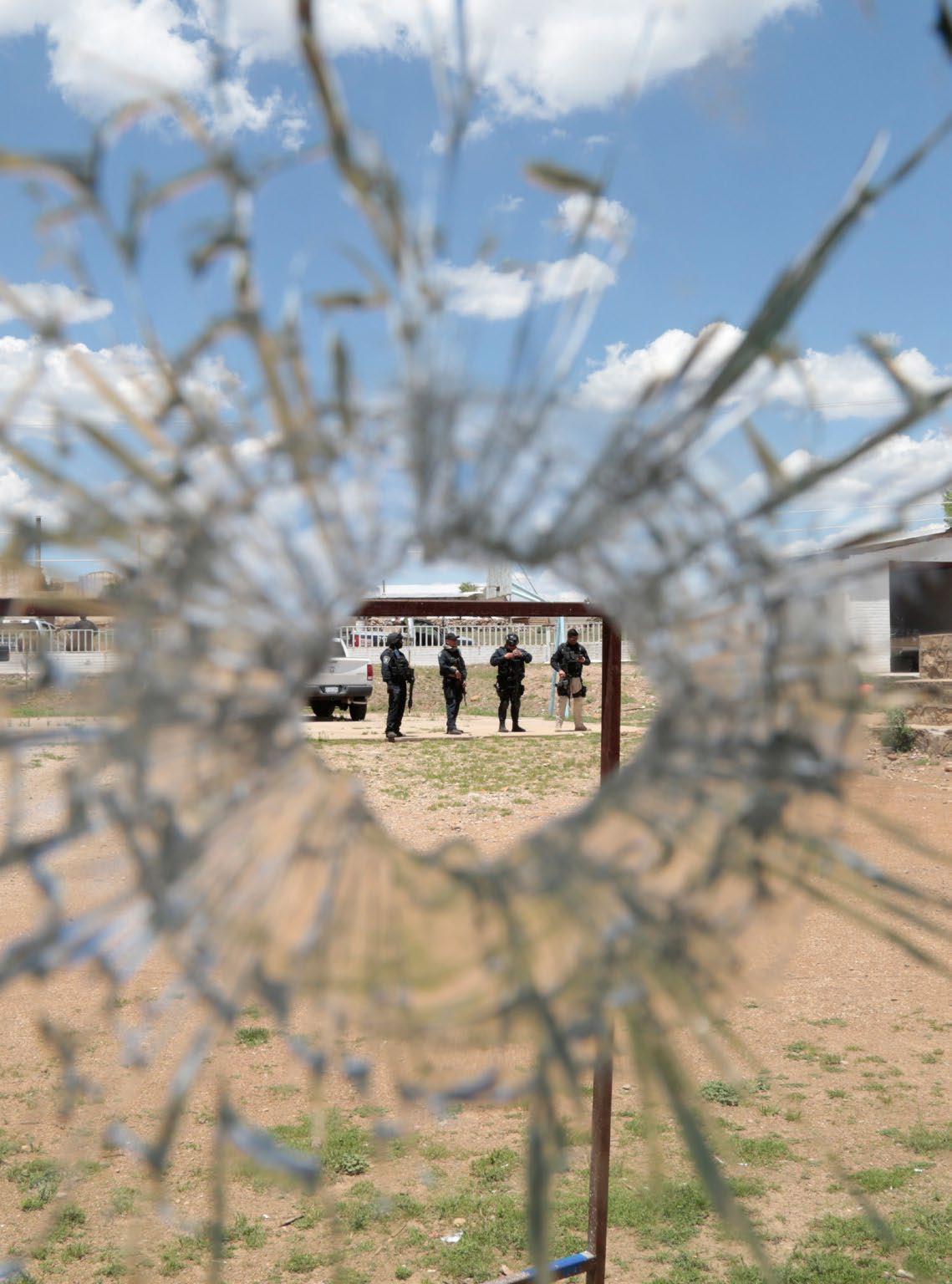
by Salome Flores Sierra Franzoni
Mexico, a country renowned for its rich cultural heritage and natural beauty, has long grappled with issues related to justice, crime, and violence. Boasting a heritage that spans millennia, a young democracy, a vibrant society, a robust economy, and magnificent nature, the country also confronts significant challenges. These arise from a complex web of factors that this article will explore, delving into the multifaceted issue of justice, crime, and violence in Mexico, and exploring its current state, root causes, and potential solutions.
To understand the current situation in Mexico, it is essential to examine its historical con -
text. Mexico has a history that dates back over 10,000 years, during which different groups ruled various regions, thriving in agriculture, trade, architecture, art, and science. These ancient groups competed for power, with those possessing stronger, more organized armies establishing empires or city-states, until they were overtaken by new groups with superior capabilities.
In the early 1500s, Spaniards arrived in the territory and built alliances with groups under Aztec domination, established in Tenochtitlan (what is now Mexico City). After defeating the ruling Aztecs, the Spanish crown governed Nueva España (part of which is now Mexico) for three hundred years until natives and mestizos joined forces to start an independ -
ence movement. In the mid1800s, after several decades of internal struggles, Mexico achieved full independency and established a federal government, guaranteeing freedom of speech and universal suffrage.
During this period, Mexico experienced soaring economic development, which mainly benefited the upper class, thus creating a gap between them and the rest of the population. In the early 1900s, rampant social inequality ignited a revolution that lasted more than 10 years. From 1920 until the end of the 20th century, Mexico was governed by a single political party that brought together political, military, labor, and agricultural leaders under strong and centralized leadership.
The root causes of banditry lay in the constant demand of these groups for a share of the benefits enjoyed by certain segments of society
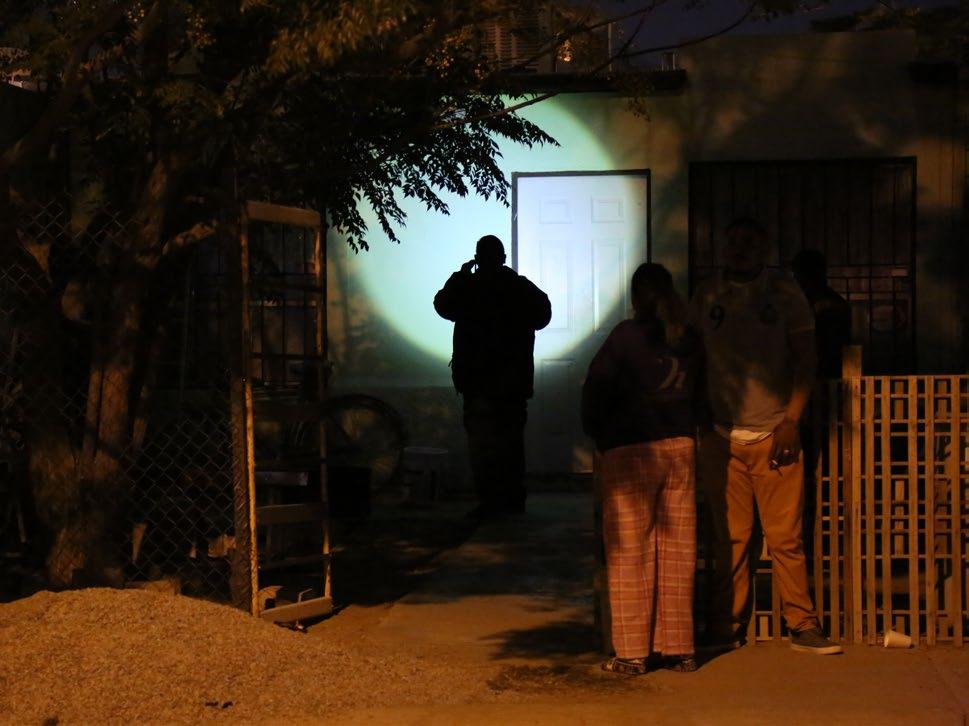
Mexico promoted significant reforms, including agrarian, labor, and education reforms, with the primary goals of establishing a democracy and enhancing working conditions and living standards for the working class, among other objectives. In the early 2000s, most Mexicans voted for a different party, breaking seventy years of political continuity and opting for alternatives that promised to strengthen democracy while promoting transparency and accountability.
In the context of insurgency, between independence and the revolution, regional armed conflicts among groups led to displacement, forcing the population to seek alternatives to meet their most basic needs, such as food and medicine. Under these conditions, the government found it challenging to focus on collecting data
and generating statistics on crime, as it was striving to consolidate central power for the modernization of the country.
In this period, the national economy did not provide stable and sufficient opportunities. Some individuals discovered that engaging in property crime, particularly theft and robbery, was an illegal yet lucratively profitable activity. The prevailing political instability created a turbulent environment where safety was nearly non-existent, especially in rural Mexico.
Banditry emerged as a well-documented phenomenon, particularly in the northern and central regions of Mexico. Organized groups engaged in theft and robbery along major transit routes. These bandits possessed a profound understanding of trade and effectively rival legal business owners, who, in many cases, were compelled to negotiate with them to avoid bankruptcy. As these bandit groups developed and maintained networks with businesses and governments, they wielded significant power, imposing their own terms. Such relationships allowed criminal groups to infil -
trate institutions, with bandits even being recruited as federal police staff, enabling them to serve both sides depending on the circumstances.
Moreover, during armed conflicts, bands of bandits were enlisted by any group promising the maximum profits to them. Within these social and commercial dynamics, rural Mexico lacked a common cause, and local leaders became enemies as they competed for economic advantages, political influence, and social status. Over time, bandits transitioned to other types of crimes, such as extortion and kidnapping.
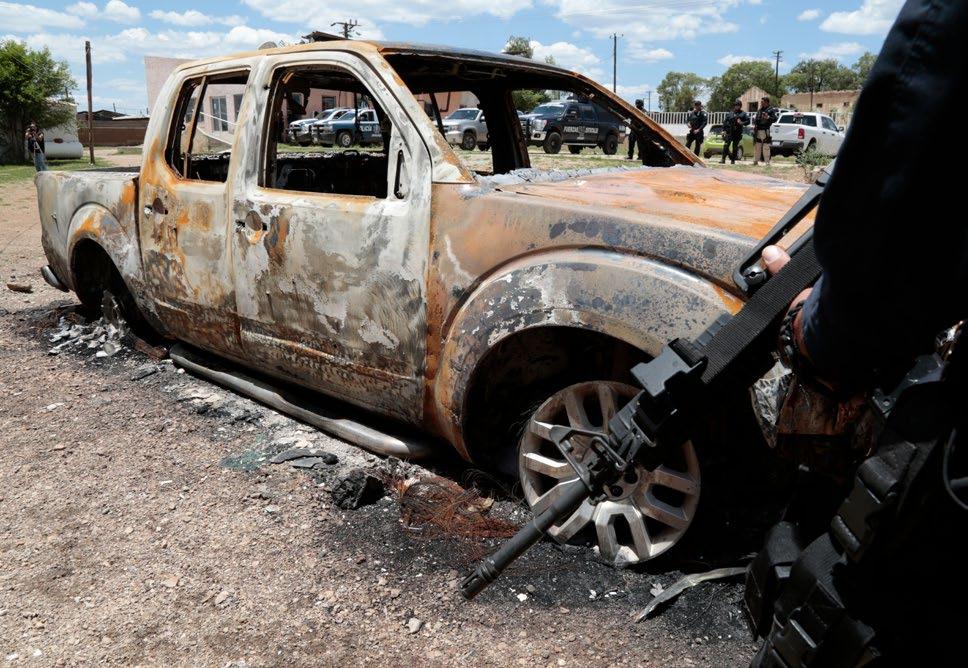

Mexican society held a certain degree of admiration for bandits, perceiving them as independent and defiant, a sentiment often echoed in popular songs. This acceptance led to complicity, with families hiding or covering for criminals and their activities. One bandit might be embraced in one town while being condemned in another. The root causes of banditry lay in the constant demand of these groups for a share of the benefits enjoyed by certain segments of society, in contrast to the limited legitimate opportunities available to the majority.
During the post-independence period, the government initiated legal changes in the Constitution and other regulations to control crime and strengthen the administration of justice.
Among the most crucial reforms, criminal justice procedures were simplified, a framework for repairing damages was established, penalties were individualized, the death penalty was abolished, and judges were granted greater independence in decision-making. A more capable and sensitive criminal justice system was seen as contributing to the legitimization and organization of state institutions, as well as consolidating democracy.
The cultivation of poppy and marijuana in Mexico was initially documented in the early 1900s. Although a market existed, its dynamics underwent a significant shift after drug use was criminalized in the United States. The cultivation of drugs took place in remote rural areas, relying on robust social networks that \ producers and distributors from law enforcement. As Mexican criminal groups gained financial stability, they were able to bribe law enforcement officials and local authorities, securing leniency and displacing other criminal networks involved in cultivating, producing, and selling drugs in the United States.
The lack of economic prospects propels individuals toward various illegal activities for survival, granting criminal groups unlimited and easy access to human capital
Over time, these groups have since expanded their activities into other illicit markets, including extortion, human trafficking, oil theft, and the smuggling of migrants, increasingly resorting to lethal violence.
Nowadays, analyzing crime and violence in Mexico is relatively straightforward due to the wealth of available crime-related data. One of the most prolific data sources is the National Survey on Victimization and Perception of Public Safety (ENVIPE), which has been conducted annually since 2011. According to ENVIPE, crime incidence in Mexico has remained stable at high levels over the last decade.
In 2012, ENVIPE estimated that 21.6 million victims experienced 27.8 million crimes. The 2017 estimates showed the highest number of victims at 25.1 million and 33.6 million crimes. By 2022, this trend has slightly reversed with figures lower than those of 2012, showing 21.1 million victims and 26.8 million crimes. The country’s population, as per the last 2020 national census, is around 126 million people. This implies that approximately one-fifth of the population in Mexico was victim of a crime in 2022.
ENVIPE employs a robust methodology, involving a sample of over 100,000 house -
Source: National Survey on Victimization and Perception of Public Safety (ENVIPE) 2023, INEGI
holds, resulting in highly accu related to the use of debit and credit cards, and 43.8% related
The number of people with access to financial services, including bank cards, has increased in parallel with the number of frauds committed, according to the latest National Survey on Financial Inclusion.
cal theory of routine activities, which posits that a criminal
gence in space and time of a likely offender, a suitable target, and the absence of capable
vergence occurs in the digital realm, with a higher number of users continuously utilizing bank cards, making them an easy target for skilled criminals who benefit from the rapid
tims, often associated with threats of harm to a family member. According to ENVIPE, extortion has the highest dark figure, with 97.4% of cases going unreported to authorities by victims in 2022.
tion ranked as the third most
lion cases in 2022. During that dents occurred over the phone, and in only 8.7% of cases did victims comply with the demands of the extortionists.
metric relationships between

In general, crime incidence is higher among men for most offenses, but women are more vulnerable to sexual crimes, with ENVIPE reporting 11 sexual crimes against women for every sexual crime against men. These include sexual harassment, groping, indecent exposure, attempted rape, and rape. This is just the tip of the iceberg; according to the latest iteration of the specialized survey on violence against women (ENDIREH) conducted in 2021, 70.1% of women in Mexico have experienced at least one type of violence during their lifetime. Moreover, 51.6% had experienced psychological violence, 34.7% physical violence, 49.7% sexual violence, and 27.4% economic, patrimonial violence, and/or some form of discrimination.
Lethal violence has shown an upward trend over the last ten years, reaching a peak of 29 homicides per 100,000 population in 2017. Last year, the rate decreased to 25 victims of homicides per 100,000 population, still one of the highest rates globally. In 2022, over half of homicides in Mexico (67.6%) were committed using fire -

arms, with most victims being men (27,389), while only 3,800 women were victims of this crime.
In this context, only 39.8% of the population feels safe walking alone near their homes at night, while 50% reported that people use drugs near their household. Additionally, 35% have witnessed others selling drugs, 31.2% have frequently heard gunshots nearby, 23.2% have observed quarrels, and 21.9% are aware of homicide cases. These indicators suggest a widespread sense of insecurity and an environment that facilitates criminal behavior.
Regarding perceptions of authorities, only 57% of the population views law enforcement authorities as effective in investigating crimes, with an equal percentage considering them corrupt. This rate is higher for judges, with 66% of the population viewing them as corrupt. The lack of trust in the criminal justice system profoundly impacts reporting rates, as more than 90% of crimes are not brought to the attention of authorities. Among the reasons for not reporting crimes, 59% of the population cited concerns associated with the authorities, 31% viewed it as a waste of time, and 14.7% lacked trust in the authorities.
Despite the extremely low rate of reported crimes, the workload of the criminal justice system remains high.
In 2022, the General Attorney’s Office had a staff of 19,479 officials, while State Attorney Offices reported a workforce of 91,768 officials, with about 80% in investigative roles. The number of investigations initiated during this period was
70.1% of women in Mexico have experienced at least one type of violence during their lifetime
77,693 by the General Attorney and 2,088,082 by the State Attorney Offices. This implies that, on average, each official would need to handle 24 investigations per year. Although this figure might seem relatively low, the duration of investigations can vary significantly, ranging from 2 months to 3 years, depending on the severity of the crime. Consequently, a backlog of cases is inevitable.
In 2022, these authorities resolved a total of 1,976,991 cases, averaging 22 resolutions per official. However, the number of pending investigations for the same year was 2,915,899, resulting in an estimated average of 32 investigations per official. Combining the number of open investigations, pending investigations and resolutions, it can be concluded that each official must manage 78 cases annually. Considering that the average number of working days in Mexico is 248 days, each official would hypo -
thetically need to complete 3.1 cases daily, which is practically impossible.
Regarding the administration of justice, in 2022, Mexican courts processed approximately 16,219 criminal cases. Of these, 8,346 were concluded, with only slightly over 1,000 cases resulting in a sentence. This highlights the substantial gap between the number of crimes committed, the number of reported and investigated crimes, and the actual number of sentences handed down.
leverages the layers of the dark web to access obscure markets, involving activities such as online child pornography and live sexual abuse
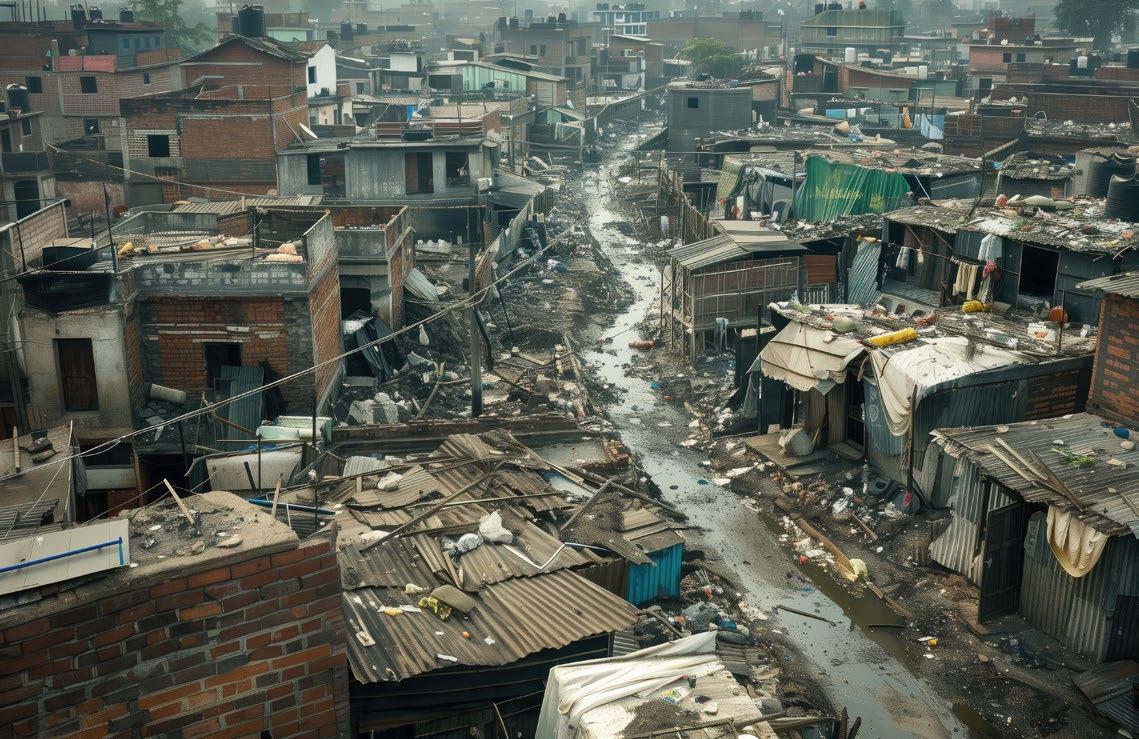

The rates of traditional crimes in Mexico have increased, concurrently with the emergence of more sophisticated and complex criminal activities. Technological advancements have facilitated the occurrence of new types of crimes, introducing a unique dimension to offenses against privacy such as identity theft, data breaches and illicit financial transactions. Harassment and hate crimes have proliferated in cyberspace as internet access expands. Systems hijacking poses significant risks, even to government institutions, potentially leading to widespread disruption and human losses, especially in critical sectors like transportation
and healthcare. Organized crime leverages the layers of the dark web to access obscure markets, involving activities such as online child pornography and live sexual abuse, thereby transcending geographical boundaries for victims, perpetrators and clients alike.
As crime and violence patterns evolve, economic inequality continues to fuel these issues in Mexico. Half of the population lives in poverty, with limited access to quality education and decent job opportunities. The lack of economic prospects propels individuals toward various illegal activities for survival, granting criminal
groups unlimited and easy access to human capital. Recruitment isn’t limited to young men; entire families contribute to logistics, transportation, surveillance, and financial management, ensuring the
90% of crimes are not brought to the attention of authorities
smooth functioning of traditional and emerging illicit markets. Furthermore, corruption and threats infiltrate law enforcement institutions, ena -
bling powerful criminal groups to operate with high levels of impunity, as the vast majority of crimes go unreported or unsolved. The line between criminal groups, society, and the state becomes blurred, making it nearly impossible to distinguish one from another in many locations.
Addressing these interconnected issues demands a multifaceted approach and strategies that prioritize economic development, quality education, and gradual crime preven-
tion targeting high-risk communities, individuals, and behaviors to ensure no one is left behind. Encouraging economic growth will lead to new job opportunities, while investing in quality education equips individuals with the skills needed for evolving industries.
Allocating resources to training, infrastructure, and policies for crime prevention by law enforcement institutions can enhance the effectiveness of combating crime. It is paramount to restore the social contract and rebuild the social
Salome Flores Sierra Franzoni is the Head of the UNODC Information Centre for researching and analyzing transnational threats related to drugs and crime based in Tashkent. Before that she was Coordinator of the Center of Excellence in Statistical Information on Government, Crime Victimization and Justice, a joint project with the National Institute of Statistics and Geography of Mexico (INEGI) and the United Nations Office against Drug and Crime, supporting 28 countries in Latin America and the Caribbean in improving crime statistics and evidence-based decision making.
Disclaimer: The opinions, findings, conclusions and recommendations expressed herein do not necessarily reflect the views and positions of the United Nations and UNICRI, or any other national, regional or international entity involved.
No data or information used in this publication was obtained from confidential sources granted under the privileges of the United Nations.
Contents of this article may be quoted or reproduced, provided that the source of information is acknowledged. The author is not responsible for the use that might be made of the information contained in this article.


The lack of economic prospects propels individuals toward various illegal activities for survival, granting criminal groups unlimited and easy access to human capital

by Cristian Mazzei

Natural resources, when effectively managed, can be a source of prosperity, wealth, and stability for a country. When mismanaged or misappropriated, they can have devastating economic, social, and environmental consequences, as well as be a significant impediment for peacekeeping and development efforts. According to renowned United Nations (UN) research, there have been at least 18 violent conflicts fueled by natural resource extraction since 1990, and conflicts related to natural resources have a higher likelihood of recurrence than other types of conflicts.1
Natural resources are defined as non-artificial products whose extraction, harvesting, or uses provide an income or types of benefits that satisfy the needs of humankind. 2 In other words, natural resources are the primary pillar in achieving sustainable development and, consequently, people’s
well-being.3 Nevertheless, natural resources, especially key commodities, 4 may also become problematic as their abundance shapes a country’s political economy and may determine the type of governance to be established.5 In fact, several authors agree that natural resource abundance is frequently linked to deficient economic growth and the emergence of conflicts in cases where a weak governance system is present in the country.6
The literature on the relationship between natural resources and conflicts identifies several reasons for the emergence of conflicts.7 First, disagreements over resource distribution mechanisms, when coupled with wealth inequalities, limited political rights, a lack of opportunities, or ethnic and religious divisions may exacerbate feelings of grievance. Second. economic opportunities and resources can serve as a
1 Alao, A. (2017). The Burden of Collective Goodwill: The International Involvement in the Liberian Civil War. Routledge.
2 Ross, M. L. (2004). What Do We Know About Natural Resources and Civil War? Journal of Peace Research, 41(3), 337-356.
Auty, R. M. (Ed.). (2001). Resource Abundance and Economic Development. Oxford University Press.
De Soysa, I. (2000). The Resource Curse: Are Civil Wars Driven by Rapacity or Paucity. Greed and Grievance: Economic Agendas in Civil Wars, London: Lynne Rienner publishers Inc
3 Sachs, J. D., & Warner, A. M. (2001). The Curse of Natural Resources. European Economic Review, 45(4-6), 827-838.
4 Ross, M. L. (2004). What Do We Know About Natural Resources and Civil War? Journal of Peace Research, 41(3), 337-356.
5 Engel, A., & Korf, B. (2005). Negotiation and Mediation Techniques for Natural Resource Management (Vol. 3). Food and Agriculture Organization of the United Nations.
6 Leite, M. C., & Weidmann, J. (1999). Does Mother Nature Corrupt: Natural Resources, Corruption, and Economic Growth. International Monetary Fund.
7 Rustad, S. C. A., & Binningsbø, H. M. (2012). A Price Worth Fighting for? Natural Resources and Conflict Recurrence. Journal of Peace Research, 49(4), 531-546.

financing mechanism for rebel groups, potentially providing initial funding through the looting of primary commodities. Third, additional mechanisms may come into play, aggravating and intensifying conflicts that are already underway. Fourth, foreign intervention mechanisms may promote a strategy where support comes from abroad, aiming to exploit control over resource wealth. Lastly, there is a mechanism where the anticipated sale of future exploitation rights ensures the continuity of rebel groups. These two latter causes are primarily motivated by greed rather than grievance, but competition over resources may also arise from the need to improve the material conditions of existence, leading to confrontations between
resource owners, those with no ownership, and those working to make the resource useful and profitable. 8 Among other interventions, mediation can play a decisive role in resolving disputes and conflicts involving natural resources. This article analyses the role of mediation as a tool to address natural resource conflicts.
Many natural resource conflicts have a dual nature as they are both technically and politically challenging. The technical complexity arises from a combination of scientific, technical, economic, and legal elements. The information regarding the status or ownership of these natural resources is sometimes ambiguous, confusing, or subject to disagreement. Moreover, natural resources are integral parts of broader supply chains that extend well beyond the immediate conflict zone. The political sensitivity arises from the economic value of the resources and the competing interests of various stakeholders involved in the dispute.
8 Collier, P. (2000). Economic Causes of Civil Conflict and Their Implications for Policy. World Bank. Washington, DC.

Natural resources are often intertwined with cultural, historical, or spiritual values, linked to group identity, or embedded in broader political conflicts.9
Mediation emerges as a valuable conflict resolution strategy capable of addressing both technical and political complexities. Mediation is a process in which a third-party assists two or more consenting parties in developing mutually acceptable agreements to prevent, manage, or settle a conflict. There are several reasons why mediation stands out as an excellent choice for settling natural resource issues.10 First and foremost, it is a versatile technique capable of resolving
difficult technical issues. It entails a variety of methods for managing technical data from various sources. Second, as a voluntary technique that requires mutual consent, mediation is well-suited to politically delicate disputes. Instead of imposing a solution on one or all sides, all participants in the conflict collaborate to create it. Thirdly, mediation focuses on building and maintaining positive connections, making it ideal for long-term issues requiring cooperation. In essence, it promotes collective decision-making and the sustainable management of natural resources. Finally, mediation can help establish a win-win situation that maximises recip -
rocal resource benefits. It has the potential to help break down entrenched or zero-sum attitudes and enhance the mutual benefit gained from natural resources.11
Despite the benefits, mediation does have some limitations. There are three situations where mediation might not be overly effective in resolving issues. One is where there are long-standing or deeply
9 Brown, M. J. (2015). Natural Resources and Conflict. A Guide for Mediation Practitioners. Natural Resource Governance Institute. https://resourcegovernance.org/
10 Castro, AP, & Engel, A (2007), Negotiation and Mediation Techniques for Natural Resource Management. Case studies and lessons learned. Food & Agriculture Organization of the United Nations, Rome.
11 Ibid.

entrenched structural issues that require significant legal, economic, political, or social adjustments. Mediation may face challenges in addressing or changing uneven or unjust power relations or societal institutions. Second, some parties may refuse to engage in discussions due to the intractable nature of values or identity disputes. In these circumstances, win-win solutions are not always attainable. Finally, situations involving a significant power imbalance or lack of trust between the parties can
also pose challenges for mediation to overcome.12
Mediation is a process, and the way it is carried out is critical to achieving a successful resolution. Assessment, preparation, bargaining, and implementation are the four key stages of mediation, according to this perspective. In the first phase, the suitability of mediation and the likelihood of reaching an agreement are determined by analysing the conflict dynamics. During the second phase, the parties
agree on the process design and establish optimal conditions for successful mediation. In the negotiating phase, the parties strive to reach a mutually acceptable agreement, aiming to strengthen relationships and move towards greater collaboration. The final phase assists the parties in resolving disagreements throughout the implementation of an agreement, enhancing its long-term viability and durability.13
The United Nations Environment Programme (UNEP) and the United Nations Department of Political Affairs (DPA) have formulated seven key messages to maximize the effect of mediation in resource disputes. These insights result from many years of involvement in natural resource mediations across numerous contexts. These lessons, when consistently applied throughout the aforementioned phases, should enable practitioners to facilitate the smooth navigation of mediations in natural resource conflicts.14
The first key message is that it is vital to understand the context of the conflict. This involves considering any peculiarities of the specific resource, its role in
12 Castro, AP, & Engel, A (2007), Negotiation and Mediation Techniques for Natural Resource Management. Case Studies and Lessons Learned. Food and Agriculture Organization of the United Nations, Rome.
13 UNEP and DPA (2015), Natural Resources and Conflict: A Guide for Mediation Practitioners.
14 Jensen, D., & S. Lonergan (2012). Natural Resources and Post-Conflict Assessment, Remediation, Restoration, and Reconstruction: Lessons and Emerging Issues. Assessing and Restoring Natural Resources in Post-Conflict Peacebuilding. Earthscan.
the conflict-ridden society, and the various forms of conflict related to that resource. Additionally, it is imperative to understand the other drivers of conflict, including the historical, political, socioeconomic, and legal contexts.15
The second major lesson emphasises the importance of having a thorough understanding of the stakeholders, including their capacities, roles, and interests. This should always include a detailed analysis that maps all of the actors’ positions and interests; assesses stakeholders’ capacity to participate in the mediation; and considers which stakeholders have a direct voice in the mediation process, as well as how other stakeholders are consulted or involved.16
The third lesson is to strive to ensure that all parties have equal access to impartial scientific and technical information, whenever possible, along with the expertise to interpret this information. UNEP frequently redirects discussions away from politically, culturally, or ideologically controversial topics. When feasible, mediation should rely on objective
norms, criteria, or facts. Technical experts, unaffiliated with the involved parties, may be brought in to provide reliable data or validate data provided by the parties. This approach becomes particularly helpful in resolving impasses arising from conflicting knowledge or incorrect views, interpretations, or conclusions held by the parties. In some circumstances, cooperative information collecting is employed to enhance transparency and build trust among the parties involved in the data-collection process. The case of Ogoniland, Nigeria,
It is a wise approach to keep ownership and management issues distinct from income distribution
serves as a notable illustration of how to turn a dispute into a technical discussion.17 When the government initiated the mediated reconciliation process, one of the first obstacles it faced was securing agreement among the parties on the facts. The information provided
by the government and the oil companies failed to instil confidence among the local communities. To break the deadlock, the administration asked UNEP to conduct an impartial environmental evaluation of the oil spill.18 The assessment procedure was just as critical as the scientific and technical outcome in this case for a successful mediation. UNEP performed the evaluation openly and transparently, aiming to involve local populations and enhance trust in the process. A total of 23,000 persons actively participated in the process, leading all stakeholders to agree on a clean-up programme based on the final assessment report as a shared and reliable data source.19
The fourth technique is to separate the ownership of resources from their usage and administration. Natural resource ownership is frequently a sensitive subject, involving matters of identity, history, and culture. It is a wise approach to keep ownership and management issues distinct from income distribution. The question of ownership is sometimes removed from the negotiating table due to its per-
15 Ibid.
16 Engel, A, & Korf, B (2005), Negotiation and Mediation Techniques for Natural Resource Management (Vol. 3), Food and Agriculture Organization of the United Nations, Rome.
17 UNEP (2011), Environmental Assessment of Ogoniland, Nairobi, Kenya.
18 Ibid.
19 Jensen, D., & S. Lonergan (2012). Natural Resources and Post-Conflict Assessment, Remediation, Restoration, and Reconstruction: Lessons and Emerging Issues. Assessing and Restoring Natural Resources in Post-Conflict Peacebuilding.
ceived sensitivity. In such cases, parties may agree to negotiate only on resource access, use, and management for mutual benefit, without jeopardising future claims.20 An example of this approach is evident in the Sudanese comprehensive peace process.
Because the parties were unable to agree on who held the oil resources, the issue of ownership remained unresolved. The solution focused solely on resource management and revenue distribution.21
The fifth lesson of mediation is to cultivate a collaborative approach that increases shared benefits. Negotiations over natural resources pose a risk of becoming a zero-sum game, especially when discussing the allocation of a limited supply of those resources. Resource mediators often employ the strategy of identifying a broader array of benefits accessible from the resource, thus expanding the pie that may be divided. Examples of resource benefits include employment, earnings, services, infrastructure, tourism, and ecological benefits. The more a mediator can assist the parties in maximising the number and variety of mutual advantages available, the more
win-win solutions become possible. One of the most important lessons learned is that win-win solutions are frequently considerably more sus-
Foreign intervention mechanisms may promote a strategy where support comes from abroad, aiming to exploit control over resource wealth
tainable than win-lose outcomes. Mediation should assist the parties in developing processes and relationships that
enable collaboration on these shared benefits in the future. 22
The sixth approach is to help parties overcome various impasses by aiding them in exploring options and envisioning a common future. Numerous strategies can facilitate discussions among parties on prospective resource conflict resolutions without endangering their current interests or requiring a political decision or mandate. Scenario-building is one such strategy that can assist in the development of credible alternative future visions for examination and comparison. Parties, in a non-committal atmosphere, can generate fresh ideas and provide constructive solutions with the help of these tools,

indirectly informing their negotiation techniques as well as the viability of mediation recommendations.23
Finally, in a mediated agreement, it is crucial to account for natural variability, uncertainty, and other potential shocks or pressures. Parties should plan for anticipated changes in the availability and distribution of specific natural resources, along with procedures for adaptation and adjustment. This is especially critical for resources threatened by climate change. Parties acknowledging the inevitability of upcoming changes lay the groundwork for future peacebuilding, which helps to ensure the possibility of achieving sustainable peace.
In conclusion, when used in the correct context and with a well-designed mediation process, mediation proves to be a powerful instrument for settling resource issues. It enables parties to collaborate towards shared benefits and build trust, which is vital for forging an ongoing relationship.

With two decades of UN experience, Cristian Mazzei is a seasoned professional in international peace and security, human rights, and governance. His roles span political affairs, policy advising, planning, and program management, both at headquarters and in the field.
As the author of the widely praised Special Assistant’s Handbook, Mazzei offers practical insights for UN Special Assistants, enhancing their effectiveness and aiding senior management in optimizing office operations.
He has made significant contributions to peace and security in diverse countries, including Haiti, the Democratic Republic of Congo, Lebanon, Central African Republic, and Somalia. His work in UNICEF and UNEP, along with insights from the UN Reform in the Central African Republic, reflects his commitment to global development.
Direct engagement with local communities has been a cornerstone of Cristian’s career, providing a deep understanding of their realities and a motivation to alleviate suffering.
Negotiation and Mediation Techniques for Natural Resource Management (Vol. 3), Food and Agriculture Organization of the

by Stefano Betti
At the 78 th session of the United Nations (UN) General Assembly held in September 2O23, President Lula of Brazil noted that deforestation in the Brazilian Amazon had decreased by 48% over the previous eight months. 1 This suggests that efforts to preserve the Amazon basin, a unique ecosystem, have gained momentum again after stag-
nating and even receding over the past few years.
A month before the UN General Assembly, Brazil hosted a summit to discuss the future of the rainforest with the other countries that share the Amazon basin. The event was not the first of its kind. The Amazon Cooperation Treaty Organization came to light in
1978 to promote sustainable development in the region. However, the 2023 summit stood apart as it marked the first time the treaty signatories had come together specifically to discuss the protection of the rainforest. They also adopted a joint plan in which they committed to increased cooperation in the law enforcement domain. 2
1 Government of Brazil, “Speech by President Luiz Inácio Lula da Silva at the opening of the 78th UN General Assembly” (2023), at: https://www.gov.br/ planalto/en/follow-the-government/speeches/speech-by-president-luiz-inacio-lula-da-silva-at-the-opening-of-the-78th-un-general-assembly
2 Agencia Brazil, “Lula: Amazon Summit’s Belém Declaration to be in-depth action plan” (8 August 2023), at: https://agenciabrasil.ebc.com.br/en/internacional/noticia/2023-08/lula-amazon-summits-belem-declaration-be-depth-action-plan#
It is too early to determine if this and other similar initiatives will effectively and durably reverse the tide of environmental degradation. What is certain is that Lula’s speech raises some fundamental questions about the intersection between two major battlefronts the world is currently grappling with: the struggle against climate change and the one against organized crime. Where do they converge? Are we going to keep waging these two battles in silos - as has been the case until now - or begin to consider how one can support the other?
The debate about how to control carbon emissions rightly revolves around the pace at which we can realistically switch to renewable energies, the usefulness of technologies aimed at capturing carbon dioxide from the atmosphere, etc. However, there exists a noteworthy gap in discussions concerning the potential contribution of “out-of-the-box” tools to the overall effort. Some of these tools broadly belong to the crime prevention policy domain.
Although the topic would deserve a much longer discussion, it may be useful to frame
the discussion by asking two broad questions: i) To what extent are organized crime groups net producers of carbon emissions? ii) How can we leverage criminal policies and tools against organized crime to maximize their contribution towards the goal of achieving carbon neutrality?
Cocaine trafficking contributes significantly to deforestation

Deforestation, often driven by criminal organizations, stands out as one of the most carbon-intensive activities. It is not resorted to solely for the purpose of smuggling timber and derived products such as paper and pulp. Another frequent objective is to make space for drug cultivation. Arson is a common method employed for deforestation, serving as a prerequisite for land grabbing purposes, whether for agricultural exploitation or real estate development. A noteworthy study 3 from 2017 highlighted that cocaine trafficking contributes significantly to deforestation. In Honduras, Guatemala,
Deforestation, often driven by criminal organizations, stands out as one of the most carbon-intensive activities
and Nicaragua, this illicit activity was found to be responsible for forest losses ranging between 15% and 30%. The issue at hand is the massive injection of proceeds from the drug trade into the acquisition of land, which is subsequently cleared and repurposed for agriculture. It is difficult to think of a more pertinent example of the links between illegal deforestation, drug trafficking, money laundering, illegal land exploitation and environmental degradation. This phenomenon has grown to such proportions that it has given rise to a new term: “narco-deforestation.”4
Beyond illegal deforestation, waste crime emerges as another major culprit in the production of carbon emissions and the release of toxic elements into the atmosphere. This occurs chiefly through the unlawful and uncontrolled burning of scraps, particularly hazardous substances. According to Europol’s 2022 threat assessment on environmental crime, “the illicit burning of waste is steadily increasing in several EU Member States, and it has many severe consequences in terms of air pollution and health hazards.”5
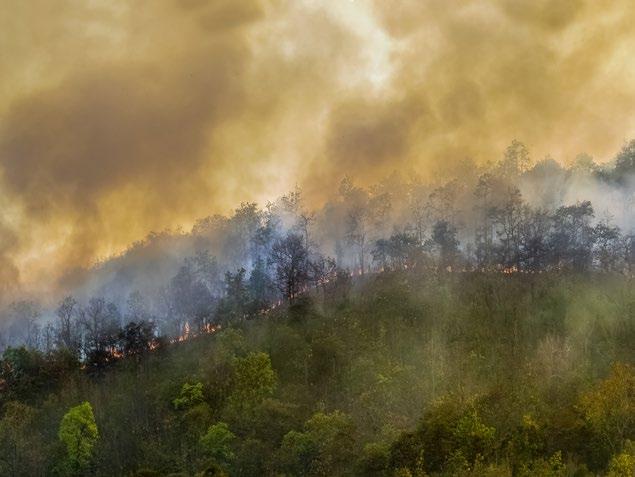
3 Environmental Research Letter, “A Spatio-temporal Analysis of Forest Loss Related to Cocaine Trafficking in Central America” (2017), at: https://iopscience.iop.org/article/10.1088/1748-9326/aa6fff
4 Our World, “Narco-Deforestation: Linking Drug Policy and Forest Conservation” (2014), at: https://ourworld.unu.edu/en/narco-deforestation-linking-drug-policy-and-forest-conservation
5 Europol, “Environmental Crime in the Age of Climate Change – Threat Assessment” (2022), at: https://www.europol.europa.eu/cms/sites/default/files/ documents/Environmental%20Crime%20in%20the%20Age%20of%20Climate%20Change%20-%20Public%20report_5.pdf
Illegal waste burning serves as a lifeline for impoverished and marginalized communities struggling to make a living
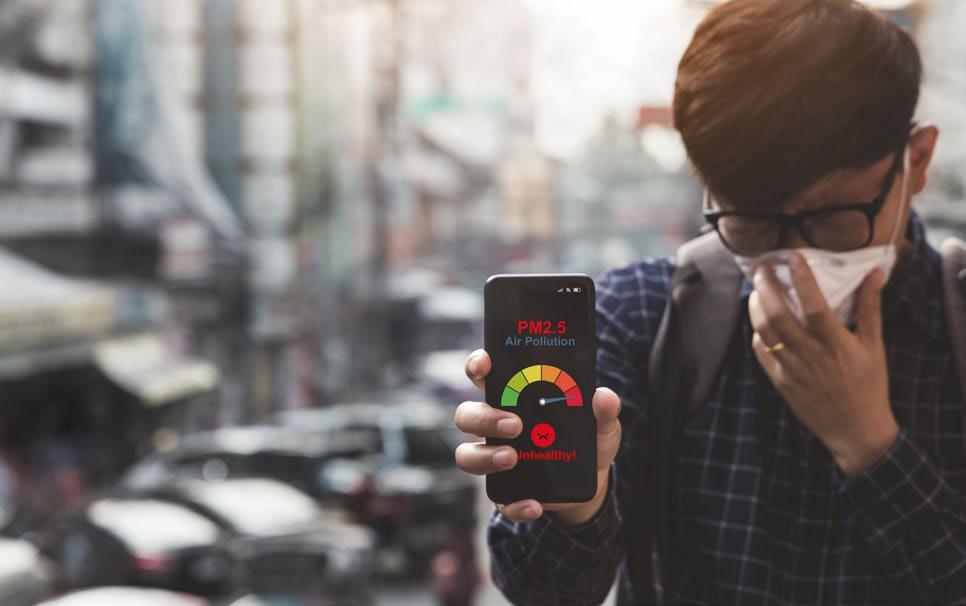
Illegal waste burning is an economically attractive option for three very diverse types of players. Firstly, it offers cost savings to unscrupulous entrepreneurs seeking cheaper, unregulated channels for disposing of their industrial waste. Secondly, it generates substantial profits for criminal syndicates that act as intermediaries by illegally transporting waste from source to destination countries thanks to their networks of corrupt law enforcement and border officials. Thirdly – and perhaps even more distressing and alarming
- illegal waste burning serves as a lifeline for impoverished and marginalized communities struggling to make a living. The garbage-ridden shantytowns of Sintesti, in the suburbs of Bucharest, made headlines in 2022 following reports that its inhabitants set fire to whatever they can find - from computers to tires to electrical cables – as long as it contains metals for resale.6
Quite intuitively, the preceding discussion implies that it is cru-
6 AP, “In Romania, ‘Modern Slaves’ Burn Noxious Trash for a Living” (April 22, 2021), at: https://apnews.com/article/world-news-health-romania-environment-and-nature-business-74bc8c9f72d2dbe21e10282c722779dc
Land seized from organized crime groups could be converted into land destined to sustainable, carbonneutral farming practices
cial for governments to engage in reinvigorated law enforcement actions to address organized crime activities responsible for significant carbon emissions. But there is much more that can be done than simply arranging a more “muscular” response. Our criminal policy and tools can themselves be repurposed in such a way as to become net contributors to climate change mitigation efforts. Without claiming to be exhaustive, three key areas appear to be of particular relevance: criminal asset recovery, counterfeit goods disposal, and the promotion of green jobs and vocational training within correctional facilities.
Action aimed at freezing, seizing and confiscating criminal property can be a powerful mechanism in our arsenals of tools for tackling climate change. In an article I wrote for the Economist Intelligence Unit’s magazine in 2019, I suggested that even a modest one or two-point increase in the percentage of assets recovered from criminal hands (the latest Europol-reported figures put the current percentage in the EU at a discouraging 2%) 7 would result in gains of several million euros for governments.8 How many new decarbonization projects could then be sponsored, green start-ups supported, energy-transition measures subsidized? Additionally, land seized from organized crime groups could be converted into land destined to sustainable, carbon-neutral farming practices. Where feasible, confiscated factories and businesses could be kept operational, with their workforce and industrial activities integrated into a logic of the “circular economy”.
7 Europol, “The Other Side of the Coin – European Financial and Economic Crime Threat Assessment” (2023), at: https://www.europol.europa.eu/cms/sites/default/files/documents/The%20 Other%20Side%20of%20the%20Coin%20-%20Analysis%20of%20Financial%20and%20Economic%20Crime%20%28EN%29.pdf
8 Stefano Betti, “Criminal Asset Recovery Must Become Governments’ Central Concern” (2019), at: https://impact.economist.com/perspectives/strategy-leadership/criminal-asset-recovery-must-become-governments-central-concern


How are we going to dispose of the staggering amount of counterfeit goods that customs agencies regularly seize around the world? In 2022 alone, the World Customs Organization (WCO) reported a total of 192 tons of illicit medicines seized by its member states. 9
This challenge also involves products that we typically perceive as innocuous, such as clothing, handbags and footwear, all of which have seen a substantial increase in counterfeiting. Addressing this issue, shall we continue to dispose of them through incineration for the most part, or shall we rather explore options like recycling, donating to charity, or potentially reintroducing them into the market once they have been verified as safe and stripped of counterfeit markings? This is not a novel problem. It has been extensively discussed and examined by organizations like the World Intellectual Property Organization (WIPO) 10 and non-governmental bodies like the Transnational Alliance to Combat Illicit Trade (TRACIT).
As much as other public institutions, it is certainly necessary and desirable for correctional facilities to be built and operated according to environmentally friendly standards. However, prison ecosystems offer the potential for a peculiar and impactful contribution to global de-carbonization efforts. Notably, by acquiring skills in green occupations and engaging in training and vocational programs during their incarceration, inmates can effectively learn the skills needed for their integration into the eco-friendly economy upon completing their sentences.
A stimulating proposal hails from the United States, where state penitentiaries are commonly constructed in spacious, secluded locations for heightened security and reduced public visibility. By making effective use of these extensive lands to cultivate fruits and vegetables or establish fish farms, these facilities present an opportunity for sustainable practices, simultaneously allowing inmates to acquire an expertise in farming and aqua -
9 WCO, “Illicit Trade Report” (2022), at: https://www.wcoomd.org/-/media/wco/public/global/pdf/ topics/enforcement-and-compliance/activities-and-programmes/illicit-trade-report/itr_2022_ en.pdf?db=web
10 WIPO, “The Environmentally Safe Disposal and Destruction of Intellectual Property Infringing Goods” (2017), WIPO/ACE/12/3 REV, at: https://www.wipo.int/edocs/mdocs/enforcement/en/ wipo_ace_12/wipo_ace_12_3_rev.pdf

culture. 11 Initiatives aimed at engaging inmates in hands-on work experiences with a view to their future employment in the green economy have also surfaced in other countries. In 2012, the penitentiary administration of the Italian region of Puglia introduced training courses focused on the installation and maintenance of solar panels.12 Another project, initiated in 2005, aimed to promote the inclusion of individuals serving sentences or released from prison by integrating them into an industrial process within the waste elec-
trical and electronic equipment recycling sector.13
The above-mentioned projects target the prison population at large, including individuals convicted of organized crime-related offenses (although those who are subject to special detention regimes may not qualify). For those sentenced specifically for environmental crimes, one might also consider a form of social service benefitting the community. This could potentially involve engaging in civic work directly instrumental to combating cli -
11 Prison Journalism Project, “How Prisons and Jails Can Go Green” (2023), at: https://prisonjournalismproject.org/2023/02/20/how-prisons-and-jails-can-go-green/
mate change and protecting the environment. Where countries already provide for the possibility of performing public service work for convicted persons, their legal frameworks could be further refined to align with this direction.
An uphill battle, but one worth undertaking
By creatively leveraging asset recovery mechanisms, implementing innovative processes for disposing intellectual property (IP) infringing goods, and providing eco-friendly opportunities for inmates, countries can simultaneously address two challenges: combating organized crime (including the risk of recidivism) while also incorporating three “unconventional” approaches into their arsenal of tools for addressing climate change.
However, this is not to suggest, that the task is without its challenges.
Concerning the possible use of confiscated assets for green projects, only a handful of countries currently possess the proper enabling legislation and solid expertise required to manage complex assets such as companies. Most countries are still unfamiliar with the
12 Oasi, “Il Lavoro in Carcere Diventa Verde” (2012), at https://www.oasisociale.it/news/il-lavoro-in-carcere-diventa-verde.html
13 Teche, “RAEE in Carcere”, at https://www.techne.org/it/attivita/carcere/raee_in_carcere/#cookieOk%23cookie_ok
This phenomenon has grown to such proportions that it has given rise to a new term: “narco-deforestation”
often-daunting challenges of ensuring that confiscated businesses can “survive” and remain competitive when subjected to the higher costs of operating “legally,” including the need to comply with health and safety regulations.
Furthermore, environmentally friendly technologies for the destruction of counterfeit goods are not always readily available. Additionally, the issue of who bears the costs for such actions remains controversial. In principle, Article 45 of the TRIPS agreement stipulates that “the judicial authorities shall have the authority to order the infringer to pay the right holder damages adequate to compensate for the injury the right holder has suffered (…).”14 In practice, though, it is very difficult to enforce this provision against counterfeiters and hold them responsible. Many infringing entities hide behind front companies or operate from uncooperative
jurisdictions. By the time a judicial decision is made, the importing companies have disappeared or have been liquidated. As a result, rights holders often bear the costs, suffering a double penalty.
Regarding the development of green training and employment opportunities for the prison population, it is not something that can be developed overnight, especially when penitentiary systems face structural problems linked to under-funding and over-crowding.
That said, it would be a mistake to dismiss the above-mentioned approaches as something only wealthy countries can afford. This may be true in some cases, but not always. Where there is a genuine window of opportunity for sweeping reforms (e.g., EU candidate countries in the process of adapting their legal frameworks and practices to h EU

14 WTO, “Agreement on Trade-Related Aspects of Intellectual Property Rights as Amended by the 2005 Protocol Amending the TRIPS Agreement”, at: https://www.wto.org/english/docs_e/legal_e/ trips_e.htm#art1

standards), the chance to include a strong decarbonization component in the reformist agenda should not be lost.
The goal of de-carbonizing the world is an uphill battle and will remain such in the foreseeable future. To make the path less steep, we should mobilize the full spectrum of available tools, including those belonging to policy areas that are typically left outside discussions about climate change. Adjusting our strategies against organized crime so that they factor in climate mitigation efforts would be good start.
Stefano Betti is an Associate Fellow at the International Institute for Strategic Studies (IISS) and the Deputy Director General of the Transnational Alliance to Combat Illicit Trade (TRACIT). He is also a consultant with several United Nations (UN) entities and the World Bank on issues of criminal asset recovery, counter-terrorism, and organized crime. From 2002 to 2013, he worked first as a criminal justice expert at the UN Office on Drugs and Crime (UNODC) and then as Senior Counsel for the International Criminal Police Organization (INTERPOL).
Prison ecosystems offer the potential for a peculiar and impactful contribution to global de-carbonization efforts
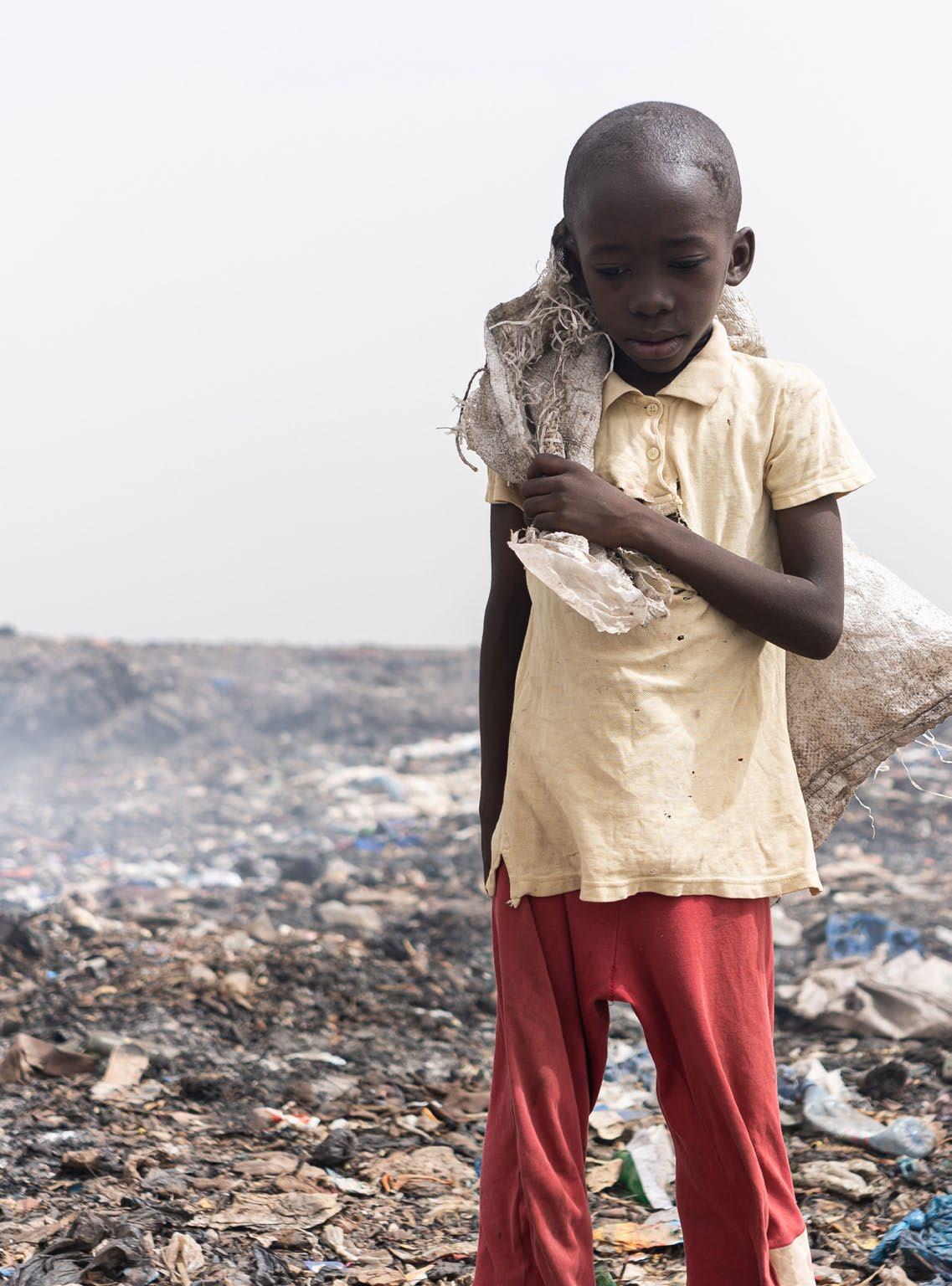
Concerning the possible use of confiscated assets for green projects, only a handful of countries currently possess the proper enabling legislation and solid expertise required
1
Matthew Burnet Stuart of UNICRI interviews Sue Miller, Head of Global Networks, Stop Ecocide International
HOW DID THE CONCEPT OF ECOCIDE DEVELOP AND HOW HAS THE CAMPAIGN EVOLVED IN THE LAST YEARS?
The term “ecocide” was first used by American plant biologist and bioethicist Arthur Galston to describe the damage caused by the use of Agent Orange, a powerful defoliant, by the U.S. army during the Vietnam war. Ecocide was also referred to by Swedish Prime Minister Olof Palme at the first United Nations (UN) Conference on the Human Environment in 1972 and has been part of academic and political discussions for the last five decades. During the years of negotiations leading to the creation of the International Criminal Court (ICC), which now prosecutes genocide, crimes against humanity, war crimes, and crimes of aggression within its remit, ecocide was
one of the proposed crimes. However, it was dropped during a closed-door, unminuted meeting for reasons which are, to this day, unclear. Severe environmental harm is covered by the Rome Statute, the ICC’s founding document, but only in the context of war.
The concept of ecocide was revived in the early 2000s by lawyer Polly Higgins, who had spent several years researching the most effective way to use criminal law to prevent the most egregious forms of environmental degradation. In 2010, she presented a proposed definition of ecocide to the UN Law Commission.
In 2017, Polly founded Stop Ecocide International with current CEO, Jojo Mehta, with the single objective of having the Rome Statute amended to

The concept of ecocide was revived in the early 2000s by lawyer Polly Higgins
include ecocide as a crime. Polly contracted cancer and died in 2019 but the movement she started has gone from strength to strength. In November 2019, Pope Francis called for ecocide to become a crime, using Polly Higgins’s 2010 definition. In 2021, the Stop Ecocide Foundation convened a panel of independent international experts (IEP) to formu -
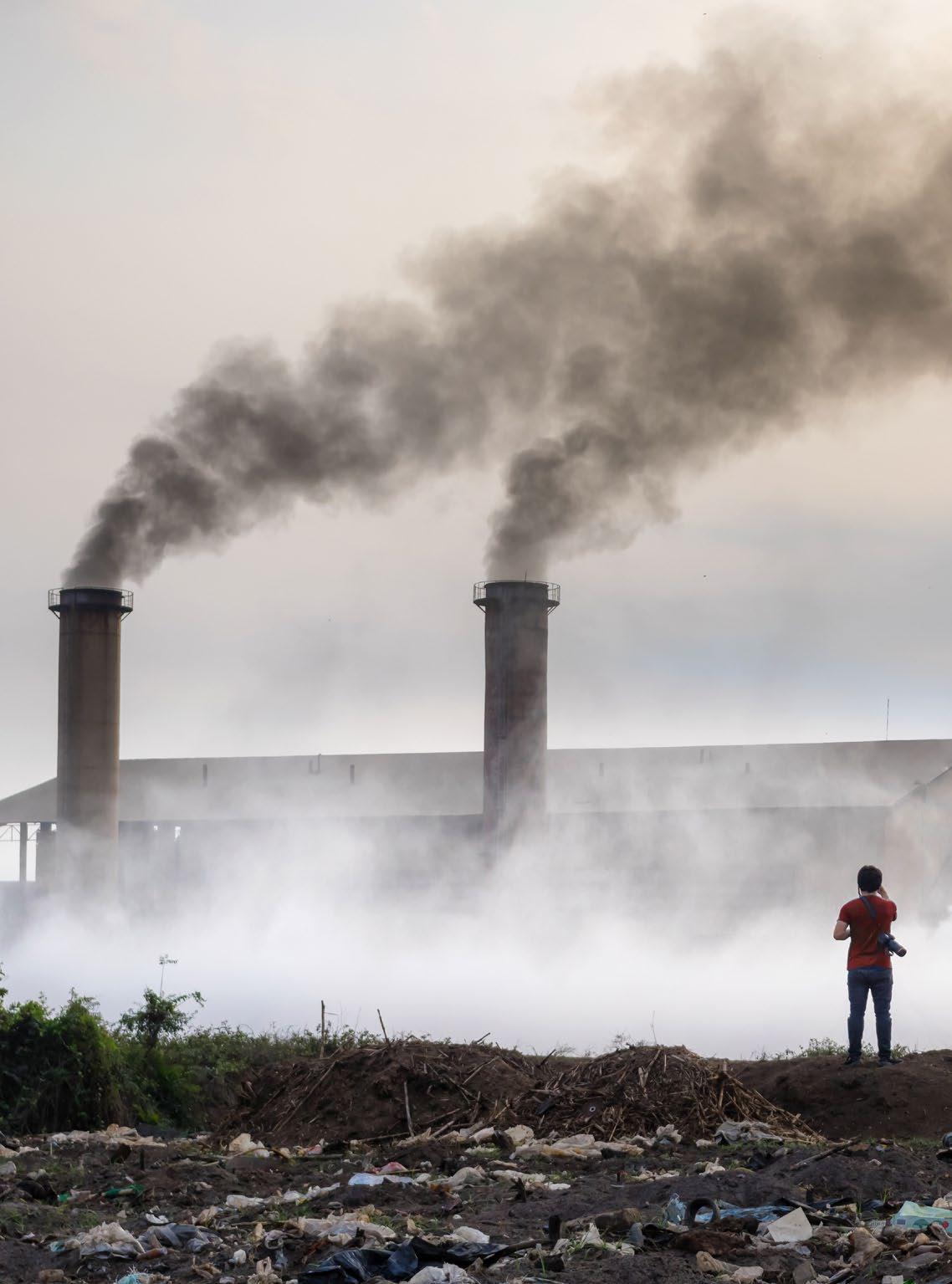
In 2021, the Stop Ecocide Foundation convened a panel of independent international experts (IEP) to formulate a definition of ecocide that could be inserted into the Rome Statute

late a definition of ecocide that could be inserted into the Rome Statute. Since the publication of that definition, at least
leaders tend to be more focused on winning than on the consequences of their actions
cess for creating the new international crime of ecocide. (since this interview Vanuatu, along with Fiji and Samoa, formally submitted a proposal to the International Criminal Court (ICC) in September 2024 to recognize ecocide as an international crime) War
27 countries are on record as having discussed it at governmental level and some have gone further. This year, Belgium voted to include ecocide law, based on the IEP definition, in its new penal code and the
European Parliament voted through an amended Environmental Crimes Directive, introducing a new qualified offence of crimes “comparable to ecocide.” As a result, European Union (EU) Member States are required to bring ecocide law into their domestic legislation by 2026. A number of countries also have ecocide bills either proposed or going through their legislatures. Currently, these include Mexico, Brazil, Peru, Italy, the Netherlands and Scotland.
On the global stage, at the International Criminal Court itself, the Republic of Vanuatu is leading the conversation, gathering a coalition of supportive states to begin the pro -

IN THE ROME STATUTE, THE ONLY EXPLICIT REFERENCE TO ENVIRONMENTAL HARM CONCERNS WAR CRIMES, SPECIFICALLY CRIMINALIZING ATTACKS KNOWN TO CAUSE WIDESPREAD, LONG-TERM, AND SEVERE DAMAGE TO THE NATURAL ENVIRONMENT. RECENTLY, THE OFFICE OF THE PROSECUTOR (OTP) HAS INITIATED A PUBLIC CONSULTATION ON A NEW POLICY TO ADVANCE ACCOUNTABILITY FOR ENVIRONMENTAL CRIMES. HOW SIGNIFICANT IS THIS DEVELOPMENT IN THE CONTEXT OF THE CAMPAIGN AND INTERNATIONAL LAW?
The public consultation initiated by the OTP is very significant and recognises the importance of using criminal law to protect the Earth at an international level. However, the consultation was launched to seek views in advance of a policy paper on how the Rome Statute as it stands could address environmental crimes, that is, without adding a crime of ecocide.
We, and many others, including Michael Mansfield KC and Co-president of Club of Rome, Sandrine Dixson-Declève, responded to the consultation, pointing out the shortcomings of such an approach and, in particular, two key issues:
1. The Rome Statute, in its present form, is concerned principally with those harms that have a direct and obvious impact on people and property – not with those harms that appear solely to affect ecosystems. A Rome Statute without a crime of ecocide takes no account of the fact that nature and humanity are interconnected, nor that obvious harm to humans as a result of environmental damage might take years to manifest, and so cannot provide adequate protection for the environment or humanity.
2. The only situation where the Statute addresses purely environmental harm is in the context of war, as a war crime, and with an exceptionally high threshold, rendering the provision ineffective, both as a deterrent and as a sanction.
We look forward to the publication of the Office of the Prosecutor policy paper later this year and to seeing how these issues are addressed.
WHAT POTENTIAL IMPACTS COULD THE CRIMINALIZATION OF ECOCIDE HAVE ON ENHANCING ENVIRONMENTAL JUSTICE AND ACCOUNTABILITY, ESPECIALLY IN CONFLICT ZONES?
Ecocide law will have a powerful effect, both in peacetime and war.
It will reach into the boardrooms of the world where many of the decisions behind the worst acts of environmental destruction are made and change the way those decisions are made. When the penalty for severe damage can no longer simply be monetised and added to a balance sheet, but instead creates personal liability for the key decision-makers, decisions involving activities with severe environmental consequences will be made much more carefully, with all possible alternatives considered. Ecocide law will affect which projects get financed and greenlit and will unleash a wave of creativity to find better, environmentally smarter ways of operating.
In times of war, its effect may be to prevent acts of destruction as a weapon of war, but it must be recognised that war leaders tend to be more focused on winning than on the consequences of their actions. The impacts of ecocide law are, therefore, more likely to be in terms of bringing
the perpetrators to justice than in prevention. Ecocide already exists as a war crime under the Rome Statute, a residue of the original intention for it to be a crime, but the threshold is so high that it has never been used to hold perpetrators to account. The ecocide law, as drafted by the IEP panel, will rectify this.
WHAT ARE SOME CHALLENGES AND OPPORTUNITIES YOU SEE IN PUSHING FOR THE CRIMINALIZATION OF ECOCIDE ON AN INTERNATIONAL LEVEL?
Criminalization of ecocide at the international level will be a game changer. It will create an international deterrent and a powerful statement that severe environmental destruction is no longer acceptable. Since ratifying states are required to bring ecocide law into their own domestic legislation, it will provide an elegant and consistent norm around the world. States will be able to prosecute ecocide within their own national courts, cases only being referred to the ICC if states are unable or unwilling to prosecute.
Ecocide law will change our relationship with the Earth, encouraging human activity that is more in harmony with nature, favouring healthier,
more regenerative practices over destructive, exploitative ones. It will provide a safe space for new technologies to develop, safeguarding the precautionary principle.
In terms of challenges, the biggest will be securing the twothirds majority of votes from State Parties required to secure
People are realising that our current laws are not protecting the environment and that something else is needed if humanity is to survive
the amendment to the Rome Statute. Having said that, as the effects of environmental destruction become ever more apparent, people are realising that our current laws are not protecting the environment and that something else is needed if humanity is to survive. Already, a number of countries around the world are in the process of creating national ecocide laws. At the ICC, a coalition of states is forming to push for the ecocide amendment. As global events unfold, the need for such legislation becomes increasingly evident.
LOOKING FORWARD, WHAT KEY MILESTONES DOES THE STOP ECOCIDE CAMPAIGN AIM TO ACHIEVE IN THE NEXT FIVE YEARS?
Stop Ecocide International has a single aim, namely the creation of a new international crime of ecocide within the jurisdiction of the ICC. The conversation there has already begun and support, both among state parties and in civil society, is growing rapidly. Our job is to encourage, foster and support that conversation, and our optimistic hope is that a new international crime of ecocide will be in place within the next five years or very soon

Polly Higgins Stop Ecocide International
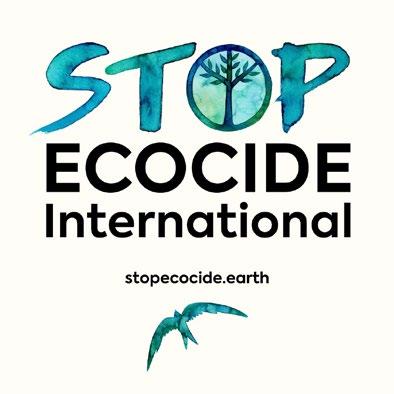
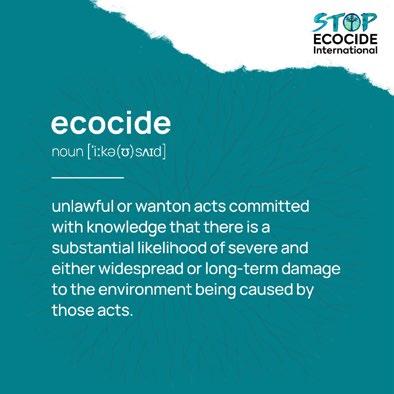

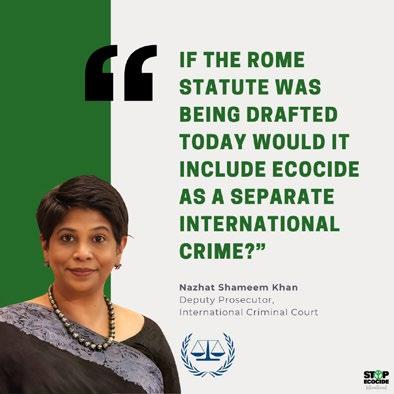

by Maria Paula Zamorano Castano
Climate change is a global crisis, casting a long shadow over our planet and its inhabitants. While the immediate consequences — rising temperatures, extreme weather events, and melting ice caps — are widely acknowledged, a hidden connection ties climate change to another pressing issue: human trafficking. Siobhan Mullally, the United Nations (UN) Special Rapporteur on Trafficking in Persons, especially Women and Children, highlighted this connection in her 2022 report.1 She expressed her concern, noting that slow-onset disasters tend to receive inadequate attention, even though they signifi -
cantly contribute to heightened trafficking risks stemming from the loss of livelihoods, displacement, migration, and increased poverty. In particular, individu-
A hidden connection ties climate change to another pressing issue: human trafficking
als already living in poverty bear the brunt of the adverse effects of climate change.
Also recognising the profound connection between climate change and human trafficking, the Inter-Agency Coordination
Group Against Trafficking in Persons (ICAT) has taken a significant step by prioritising the nexus of climate-induced displacement and human trafficking in its 2024 work plan.
In this short commentary, we will delve into the intricate interplay between these seemingly distinct issues and examine how climate change exacerbates the problem of human trafficking. Moreover, we will explore potential solutions to address this multifaceted crisis, emphasising the urgent need to confront the everyday consequences of climate change and its profound impact on vulnerable populations.
1 https://www.ohchr.org/en/documents/thematic-reports/a77170-report-special-rapporteur-trafficking-persons-especially-women


A key factor linking climate change to human trafficking is its disproportionate impact on at-risk populations. Developing countries, with limited resources and infrastructure, are often the hardest hit by the effects of climate change. People in these regions rely heavily on agriculture, fishing, and natural resources for their livelihoods, making them highly susceptible to the disruptions caused by extreme weather events and environmental degradation.
As climate change worsens, these communities face reduced access to clean water, arable land, and food. The resulting economic hardship and food insecurity can lead to desperation, making individuals more vulnerable to exploitation and trafficking.
For example, the UNICRI 2022 report on Climate Change and Violent Extremism2 vividly illustrates the growing vulnerabilities among farmers in specific regions of Africa. It highlights how prolonged arid seasons push these farmers to migrate to southern cities in search of employment opportunities. Additionally, the report docu -
ments the challenges faced by fishermen who, as a result of escalating desertification and unpredictable rainfall patterns, are forced to contend with increased competition among fellow fishermen while also facing militant groups as they venture into more remote and less secure areas in search of fish.
A more recent and increasingly prevalent example can be found in labour exploitation at sea. With the demand for fishing vessels rising due to depleting fish stocks, traffickers target many vulnerable communities desperate for work. These individuals are often lured with
2 https://unicri.it/sites/default/files/2022-10/Perceptions%20of%20climate%20change%20and%20violent%20extremism_0.pdf

A significant portion of the 30 million people working at sea are victims of labour exploitation as a result of human trafficking
false promises of improved living conditions and better opportunities. Tragically, many find themselves trafficked and subjected to exploitation at sea, often with limited means of escape. Human Rights at Sea, 3 an NGO advocating for the human rights of all individuals at sea, has identified that a significant portion of the 30
million people working at sea are victims of labour exploitation as a result of human trafficking.
Another critical aspect of the climate change and human trafficking link is environmental displacement. Rising sea levels, extreme weather events, and slow-onset environmental changes like desertification force people to abandon their homes in search of safer, more stable living conditions. This mass migration often occurs across borders, making dis -
placed individuals highly vulnerable to human trafficking.
Human traffickers prey on those seeking refuge, offering false promises of jobs, safety, and a better life. They exploit the desperation of environmental refugees, subjecting them to forced labour, sexual exploitation, and other forms of abuse.
Canada serves as a compelling case study where the repercussions of rising sea levels have significantly influenced the landscape of human trafficking. A study in the region unearthed a concerning trend linked to the melting Arctic ice, which
3 https://www.humanrightsatsea.org
has caused the Arctic waters to expand.4 This expansion, in turn, has given rise to new shipping lanes along the Northern passages. These emerging routes have become attractive options for traffickers seeking less monitored avenues, primarily due to a lack of comprehensive mapping.
Consequently, there has been a notable increase in human trafficking cases within Canada. Victims trafficked from Northern Europe often pass through Canada as a gateway to the Americas, capitalising on the newly established, more efficient, and cost-effective routes made accessible by the changing Arctic landscape. This underscores the complex interplay between environmental shifts and their far-reaching sociological consequences.
Climate change can also exacerbate conflict, which in turn fuels human trafficking. As resources become scarcer due to environmental degradation, competition for them intensifies, potentially leading to conflicts. Displaced populations are often caught in the crossfire, facing violence, instability, and a breakdown of social structures.
Human trafficking thrives, with traffickers seizing the opportunity to exploit the desperation of those seeking refuge from the ravages of war and persecution
In such chaotic environments, human traffickers find fertile ground to operate. They exploit the chaos and vulnerability, coercing individuals into various forms of trafficking, including the recruitment of child soldiers and sexual slavery.
The 2018 UNODC Report on Human Trafficking in Armed Conflict 5 serves as a crucial document, highlighting the dire consequences of conflict for
vulnerable populations. Within the tumult of conflict, individuals often find themselves subjected to a harrowing array of experiences, including abuse, violence, and exploitation.
In such environments, human trafficking thrives, with traffickers seizing the opportunity to exploit the desperation of those seeking refuge from the ravages of war and persecution. As the report aptly notes, “the need to flee war and persecution may be taken advantage of for exploitation by traffickers.”
Furthermore, forced displacement amplifies the risks of human trafficking in conflict areas, driven by the large numbers of refugees who become susceptible targets.

4 Hoogensen Gjørv, G. et al. (2009) ‘Human Security in the Arctic - Yes, It Is Relevant!’, Journal of Human Security, 5, pp.1-10.
5 UNODC, Global Report on Trafficking in Persons (2018), Booklet 2: Trafficking in persons in the context of armed conflict (United Nations publication, Sales No. E.19.IV.2).
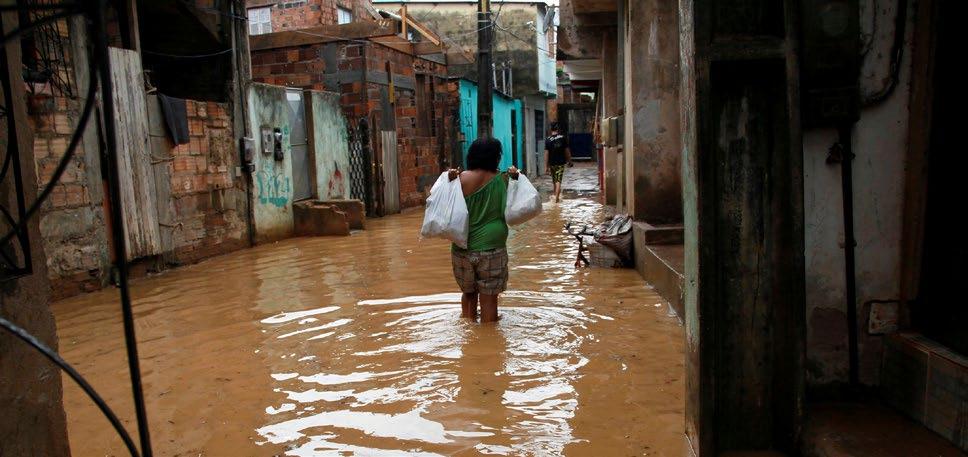
These conflict zones offer a fertile ground for traffickers to engage in various forms of exploitation, with the report underscoring that “in conflict areas, trafficking in persons for sexual slavery, recruitment of children into armed groups, forced labour, and abduction of women and girls for forced marriages are the most commonly reported forms of trafficking.” This multidimensional crisis necessitates a comprehensive understanding of the complex intersection between conflict and human trafficking, which is exacerbated as a result of climate change.
Climate change affects men and women differently, often exacerbating existing gender inequalities. In many societies, women have limited access to resources and decision-making
power, making them more vulnerable to the impacts of climate change. As highlighted by the 2022 Special Rapporteur on Trafficking in Persons, especially Women and Children, gender shapes the experiences of climate-related disasters, which can further exacerbate human trafficking in communities experiencing gendered inequalities and systemic discrimination.
Women are disproportionately burdened with responsibilities like water collection and food provision, which become more challenging as resources dwindle. This heightened vulnerability can lead to situations where women are trafficked for forced labour or sexual exploitation.
Once again, Canada provides a striking example of how climate change intertwines with
human trafficking dynamics. As previously noted, Canada’s Arctic region has witnessed the creation of new sea passages due to melting ice. These passages not only provide traffickers with less scrutinised routes to transport victims but also attract commercial development ventures, particularly in the tourism sector.
Regrettably, as tourism surges in newly accessible areas, the demand for sex work often follows. This places indigenous communities near these development zones in a precarious position, with increased vulnerability during the construction phase, as non-resident male workers contribute to the demand for commercial sex work. Furthermore, upon the completion of development projects - such as bars, restaurants, and hotels catering to tourists - an interdependent
relationship with sex work often emerges.6 Providers of commercial sex, unable to meet the heightened demand, may turn to these already disadvantaged indigenous communities. This includes women who are survivors of sexual violence or individuals desperate for employment or better living conditions. In such circumstances, human trafficking and sexual exploitation can become distressingly prevalent, further exacerbating the challenges these communities face.
Recognising the interconnectedness of climate change and human trafficking is the first step in addressing this intricate challenge. Effectively tackling this issue requires a comprehensive approach that blends environmental, social, and economic strategies.
It is crucial to acknowledge that climate change poses an escalating concern for our planet,
demanding proactive measures. However, addressing this complex issue is far from straightforward. Consequently, the focus should be on developing human trafficking prevention and adaptation strategies.
One effective preventive strategy involves understanding the specific vulnerability factors within each community and working to mitigate them. This may include improving access to essential resources like food and water, as well as promoting infrastructure development that fosters job opportunities.
Take Tuvalu as an illustrative example - a nation grappling with a high incidence of labour exploitation, exacerbated by rising sea levels due to climate change.7 Despite the challenges, the Tuvaluan government has taken proactive steps by providing its citizens with legal advice, education on their legal rights, and study support for aspiring young lawyers. These initiatives empower citizens to safeguard their rights and protect themselves from traffickers seeking to exploit them.
Furthermore, extending legal protection and support to environmental migrants can significantly reduce the risk factors associated with refugee status.
These are just a few examples of what states can do to proactively prevent vulnerabilities from escalating, thereby curbing the risk factors for human trafficking.
On the international front, there are additional avenues to better understand the interplay between climate change and human trafficking. Increased research on the effects, causes, and consequences of specific climate events, such as Arctic melting, can provide deeper insights into their interconnectedness and help identify avenues for enhancing preventive measures. Moreover, such research can yield valuable data that informs the improvement of law enforcement monitoring in areas affected by climate change, which have unfortunately become fertile grounds for human trafficking.
6 Lusby, C. and William, L. (2015) ‘Sex Trafficking In The Tourism Industry’, Journal of Tourism and Hospitality
7 https://www.imf.org/en/News/Articles/2023/07/26/cf-tuvalu-needs-to-build-resilience-amid-threat-from-rising-seas
The link between climate change and human trafficking is a sobering reminder of the far-reaching consequences of environmental degradation. As our planet continues to warm, vulnerable populations face increased risks of exploitation and displacement. To address this complex nexus, we must take proactive steps to mitigate climate change, support affected communities, and raise awareness about the challenges faced by those at the intersection of these two crises.
Climate change and human trafficking are global issues that require a coordinated, multidimensional response. By recognising the hidden link between these problems and taking decisive action, we can work toward a more sustainable and just future for all.

Maria Paula Zamorano Castano is a dedicated professional in the field of human rights and international criminology. With a strong educational foundation in Forensic Science, coupled with a Master’s in International Criminology with a specialisation in Human Rights Law, Maria is deeply committed to countering human trafficking. Currently serving as an individual contractor for the United Nations Interregional Crime and Justice Research Institute (UNICRI), Maria brings extensive knowledge and experience to the intersection of human trafficking and climate change. Passionate about finding innovative ways to diminish and prevent this crime, Maria’s expertise lies in understanding the complex dynamics of the issue and advocating for solutions at the intersection of law, science, and human rights.
by David Fraser Harris
There are times and situations when the last thing you want to do is talk; and there are times and places where words are not going to help. But when the opportunity does appear, the right mindset can make all the difference. Surely, part of that mindset has to be, quite simply, never giving up on dialogue, which also implies never letting go of the conviction that there is goodness in everyone, be that partner, opponent or even enemy.
UPF is in its twentieth year; before that, it stood on the foun -
dation of decades of peace work in a variety of fields. Here are some examples: the International Conference on the Unity of the Sciences (from 1968); the Professors World Peace Academy (from 1973); the Youth Seminar on the World’s Religions (1982); and the Summit Council for World Peace (1987). Here are the titles of some conferences hosted by the Council for the World’s Religions: The Trinitarian Basis of Christian Unity (Moscow, 1989); Intra-Jewish Dialogue (Switzerland, 1986); Intra-Hindu conference (Vara -
nasi, India, 1986); Family and Law in Islam (Istanbul, 1989). In 1991, the International Religious Foundation published World Scripture: A Comparative Anthology of Sacred Texts All these forerunners find their counterparts in the current structure of UPF, which approaches peace from many angles: political, religious, cultural, academic, economic, and media.
I mentioned the importance of the right mindset. Here’s an example of the importance of simple service and the read -


iness to listen. It happened in 1979. A young Japanese Unification Church missionary was visiting houses in Birmingham, offering to help in any way. The occupant of one house opened his door, saw the young man, and slammed his door shut. The young Japanese man wondered what to do, and decided to buy a gift. He came back the next day, knocked again, and stood, half-bowing, holding the gift in front of him. The Englishman thought for a moment and then said: “You’d better come in.” In conversation that day and during further visits, the Englishman told his story. Forty years previously he had been one of 1600 British prisoners of war in Singapore. He said almost all of them had been killed by the Japanese; he was one of the very few survivors. This explains why he had slammed the door on
seeing a Japanese face. The visits continued for several months, until one day the Englishman said to the young man: “Today I would like to take you to visit my church.” In the car on the way, he said to the young man: “Forty years ago, when the British army arrived, they liberated my body. In the last three months, you have liberated my spirit.”
Sometimes it is courage and vision that open the way. At UPF’s 2019 Southeast Europe Summit in Tirana, I met Dr. Marijan Orsolic, who told us about Pontanima, the ‘SoulBridge’ interreligious choir. Following the tragic conflict in Bosnia from 1992 to 1995, which resulted in more than 400,000 people being killed or injured, Dr. Orsolic chose to highlight some moving examples of people coming together to heal the wounds,
in a ‘land of broken bridges.’ Pontanima was created by a fellow Bosnian, the Franciscan monk, Father Ivo Markovic, to unite people through the universal power of music. With not enough Catholics to form a choir, Father Ivo invited members of other faiths to join, and Pontanima was born. Growing from 12 to 60 members, the choir has performed more than 350 times, all over the world including at the United Nations Headquarters, and progressed from Catholic to Orthodox to Jewish, Islamic and African styles. Meeting many challenges, such as singing songs of ‘the enemy,’ it has allowed so many friendships to be made, relationships to be rebuilt, and has initiated the re-humanization of an entire people.
In the last three months, you have liberated my spirit
The Religious Youth Service (RYS) has been bringing young people of different faiths together since 1985 – this project successfully changed the dynamic of dialogue from table talk to combined efforts, the youth discovering the goodness of each other as they work together to help a community. At our Hungary project in 1991, 100 such young people took on pro -
jects at a school in Tatabanya, an old people’s home in Pecs, and an orphanage in Fot; then they met for two days at a 1000-year-old monastery in Pannonhalma. A Jewish girl from Israel told us: “Every day of my life I see Muslims and Christians in my town, but I never speak to them. Here in Hungary, I have worked alongside them and they have become my friends.” RYS Jordan in 2004, organised in cooperation with Jordan’s Higher Council for Youth, brought young people from across the region to Salt, near Amman. The work involved repurposing a disused building as a skills training centre for local women. The educational and cultural program included visits to the tombs of Joshua and Shuaib (Jethro); Mt Nebo, where Moses is said to have died; the Dead Sea; and Petra. The Palestinian parents of one Jordanian Christian participant told me: “When
Meeting many
challenges,
such
as
singing songs of ‘the enemy,’ it has allowed so many friendships to be made, relationships to be rebuilt, and has initiated the rehumanization of an entire people
we see what you’re doing, we feel hope.” A 2008 project in Lebanon brought together Armenian Christian scouts with Sunni and Shia Muslim scouts to paint a peace mural outside the town hospital in Nabatieh, Southern Lebanon. On the bus back to Beirut, one scout commented: “For the first time in my life, I really had the feeling that we are one country.”


In addition to its major contributions to interfaith dialogue, UPF is often seen as an impartial actor in the fields of leadership and governance. I will include two examples here. In 2006, following a period of civil war, the Liberian government established a truth and reconciliation commission. As reported in The Analyst : “Calling on the UPF last Friday at the Capitol Building in Monrovia, the Chairman of House Standing Committee on Peace and National Reconciliation, Mr. Wesseh Blamo, praised the UPF for having conducted a highly successful reconcilia -

tion conference from February 9 – 11, 2006 in which about 300 delegates from counties of Liberia and countries of the Mano River Union participated. According to the lawmaker, the model of peacebuilding used by the UPF would assist the TRC in carrying out its mandate, hence the need to assist in enhancing the national endeavour.”
The second example comes from Nepal. UPF-Nepal played a significant part in developments following the Maoist insurgency and civil war. UPF held six South Asia Peace Initiative Conferences
that brought together Monarchists, Maoists, and members of the Seven-Party Alliance to dialogue on issues and modalities of Nepal’s peace process. At a 2008 Parliamentarians for Peace conference, the former Education Minister, Mr. Ram Hari Joshy, called the conference “a dream come true.” Nepal, he noted, was passing through a stage of peace, but to achieve lasting peace the root problems had to be addressed. At the close of a July 2009 conference, Nepal’s former prime minister thanked UPF Chair, Hon. Ek Nath Dhakal, Member of the
For the first time in my life, I really had the feeling that we are one country
Constituent Assembly and organizing chairman of the conference, “for the highly successful, unprecedented, and very productive series of back-to-back of peace initiatives.”
One explanation for UPF’s impartiality can be found in its five principles of peace, which serve as a common point of reference for UPF’s worldwide network of ambassadors for peace. Here is the first of the five: “We are one human family created by God. The way to rise above the pursuit of self-interest is to recognize our common humanity, given to us by our Creator. Just as a parent can intercede in the disputes of children, the parental heart originating from the Creator can help us resolve the differences that exist between nations, cultures, and religions.” This mindset – the heart of a parent – lies behind our approach to dialogue. This is what made possible UPF’s series of Europe-Eurasia conferences, the fourth of which took place in Chisinau, Moldova, in December, 2014. Already in 2014 Ukraine was experiencing a
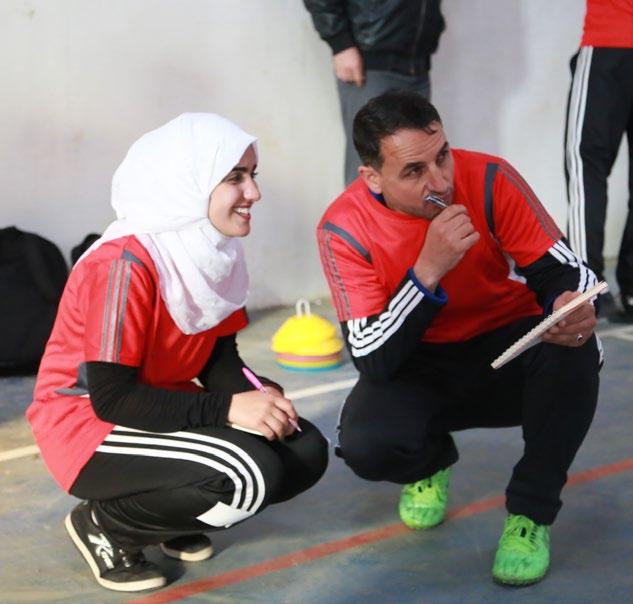
crisis. In such circumstances, the fourth UPF conference on “Europe-Eurasia dialogue” was both a source of expectation and concern: could the conference avoid an open confrontation between Russian, Ukrainian, and Moldovan participants? UPF-Eurasia invited prominent Ambassadors for Peace from these three nations; they came with a mindset of dialogue, and although everyone expressed their positions frankly, the debates were handled serenely.
Another such conference focussed on the conflict in Syria. Following earlier conferences, UPF convened on the theme, “Syria: Opening Lines of Communication and Soft
Power Approaches to Peace,” in Cyprus in December, 2016. The invitation stated that the conveners “are hoping to establish an environment where agendas - political, religious or other - are set aside, while participants come to listen and communicate.” Dr Mohammed Habash, co-host of the conference, shared: “Five years of meetings between the opposition and the regime have brought no reconciliation; only mutual recriminations… I believe that this can be considered the first time an international organization has brought together representatives of both the regime and the opposition.” Participants from outside the country included a former Ambassa -
Sport has the power to change the world. It has the power to inspire. It has the power to unite people in a way that little else
dor of Syria to the UK, a former Economic Advisor to the Prime Minister of Syria, the former President of Damascus University, along with writers, academics, activists, and businessmen, spanning opposition views from moderate to outspoken. From inside Syria came a member of the Parliament and a representative of the Government’s Ministry of Reconciliation. Mr. Thabet Abbarah invited the entire conference group to a Syrian dinner at his restaurant in Nicosia. When he first opened the restaurant four years earlier, he put a sign outside, saying: “Nobody who supports the Assad regime is allowed to enter.” This time, however, the two delegates from Syria enjoyed a wonderful meal together with us. A sense of deep commitment to peace and love for Syria permeated the entire closing session of the conference. Austria’s former Defence Minister described the conference as one
of the most fruitful he had attended. “There is a will from both sides to end the bloodshed and enter a new phase of getting common Syrian ownership of common Syrian affairs. I felt the common Syrian spirit from all sides. You could feel there is the will not only to be Syrian but to build a new Syria.”
UPF’s Middle East Peace Initiative has been promoting peace since 2003 through dialogue, people-to-people diplomacy, fact-finding trips, interfaith pilgrimages, and conferences. Over the course of 11 years, this brought no fewer than 44 delegations to Israel, the West Bank, Gaza, and Jordan. Coming from the corners of the earth, these delegations ranged in size from 50 to 500, bringing together religious leaders, parliamentarians, academicians, women leaders, youth, and civil society representatives. The visits spawned some 26 related programs, including youth programs, service projects, art exhibitions, theatre performances and charity concerts. In recent years, a series of webinars explored the implications of the Abraham Accords, before turning to common areas of concern and interest, such as economic development and responses to desertification. In November 2022, a hybrid conference, arranged in partnership with the Al-Liqa’ Centre for Religious, Heritage and
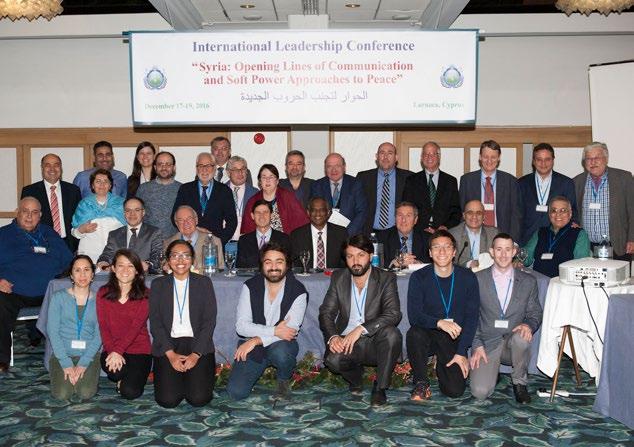
Cultural Studies in the Holy Land, focussed on The Reality of the Church and Christians in the Middle East.
Dialogue, then, may not be so much about talking as about finding ways to be together, to hear the heart of the other
In the words of Nelson Mandela, “Sport has the power to change the world. It has the power to inspire. It has the power to unite people in a way that little else does.” Following the success of a series of Play Football, Make Peace programs completed in the early 2000s through a sister organization of UPF, Robin Gra -
ham founded the Peace Club in 2013. With its Champions in Life Blueprint, Peace Club works with football coaches to foster virtues - virtues like commitment, self-control, respect, cooperation, creativity, and initiative. This allows football to reinforce the growth of character in the players, contributing to their personal development and success. Peace Club has run programs for coaches in Jordan, Lebanon, Palestine, Oman and Qatar, and now has a dynamic program in Senegal. As Robin puts it, “Players may not become champions in the game. Very few reach that level of competition. But each young person who touches the ball can and should become a ‘champion in life.’ Our 11th virtue is sportsmanship. The practice of good sportsmanship is real peacemaking. The world needs it more than ever.”
The practice of good sportsmanship is real peacemaking. The world needs it more than ever
“People often think that politics moves the world, but that is not the case. It is culture and art that move the world.”
UPF’s co-founder, Dr Hak Ja Han Moon, had in mind the Little Angels of Korea when she wrote these words. The Little Angels are a children’s folk dance and singing company that was established in 1962 with the mission to bring the spirit of peace around the world while displaying Korea’s beautiful traditional heritage. They have performed in over 120 countries. Their beauty and innocence never fail to move people’s hearts, but surely never more so than in Pyongyang in 1998. Upon arrival from Seoul, they were met by North Korean children. The children – from North and South – immediately felt connected with one another,

especially since they shared the same cultural heritage and sang the same songs. Film footage shows the North Korean audience breaking into smiles, and occasionally shedding quiet tears. Such is the power of art. Composer David Eaton, addressing a webinar on ‘Culture as Peacemaker’ and referring to Vedran Smailović, known as ‘the cellist of Sarajevo,’ sums it up this way: “Art shows there are better ways to resolve conflict than war. Instead of turning to power when justice fails, and turning to war when power fails, let us use art to rise and look higher, toward true love.”
Dialogue, then, may not be so much about talking as about
finding ways to be together, to hear the heart of the other, and to discover the goodness that will enrich our world. Perhaps its value is greater than we think: beyond serving as a means to solve conflict and misunderstanding, perhaps it is an echo of life itself. After all, it is in relationships with others that we find our identity and our value. That may be one more reason to never give up. In tribute to one of the great masters of dialogue, Paolos Mar Gregorios, let me end with his explanation of the word: while many assume the “di” in dialogue refers to ‘two’, in fact it is the “dia” in dialogue that refers to ‘through’. What we need to do is ‘talk things through.
David Fraser Harris is the Secretary General for the Middle East and North Africa of the Universal Peace Federation (UPF). From 1990 to 1997, Mr. Fraser Harris served the International Religious Foundation (IRF) as the Director of its European office in Rome, responsible for the promotion of IRF’s interfaith programs in Europe, which included both conferences and the international projects of the Religious Youth Service. From 1997 to 2012 he and his family lived in Damascus (Syria), where he taught English and travelled frequently to support UPF programs in Lebanon, Jordan and Turkey, and sometimes to Egypt, Morocco and nations in the Gulf. He continues to support such programs from his home near Edinburgh.



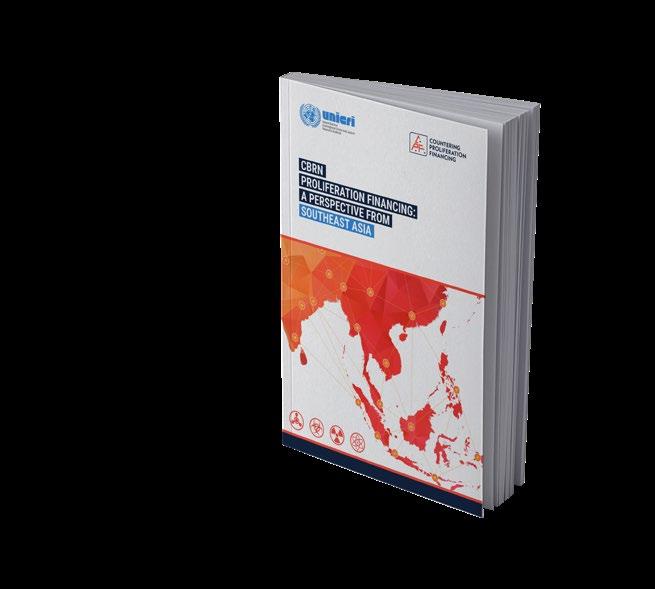


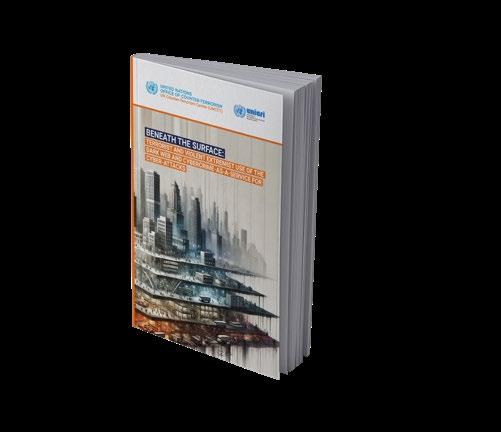


The convergence of terrorism and violent extremism conducive to terrorism with cybercrime presents a formidable challenge. The United Nations Global Counter-Terrorism Strategy (A/RES/77/298), and its successive reviews, have expressed concern over the misuse of the Internet and other information and communications technologies by terrorist groups and individuals, yet the intricacies of the relationship between terrorism and violent extremism on the one hand and cybercriminality on the other remain nebulous – particularly in the darker corners of the Internet.

The report “Cultural Heritage Smuggling and the Nexus with Terrorism” delves into the intricate and pervasive issue of cultural heritage smuggling, with a specific focus on antiquities. This report highlights the significant connection between this illegal trade and terrorism, showcasing how terrorist and insurgent groups leverage profitable illegal markets to finance their activities and further their agendas.
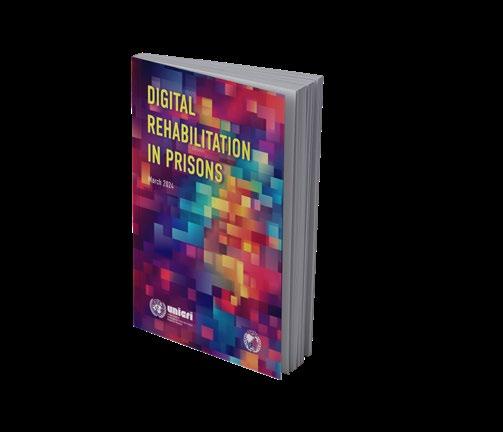
This report examines the potential benefits and risks of introducing new technologies in prisons to facilitate prisoner rehabilitation. It aims to assist policymakers, practitioners, and those responsible for the design and delivery of rehabilitative programmes to understand how to leverage technologies to support prisoner rehabilitation effectively and ethically.


